Goa, a paradise for beach lovers, is also home to a wide variety of birds, from resident to migratory species. The state is a perfect habitat for birds as it boasts of mixed forests, rivers, and wetlands, mangrove forests and grasslands, supporting birds of various kinds.
The unique ecosystem of Goa attracts hundreds of birdwatchers and ornithologists from all over the world who come to observe and study the diversity of birdlife that thrives in this tiny state on India’s west coast.
Whether you are a birding enthusiast or a casual observer, Goa’s birdlife will surely leave you spellbound with its kaleidoscopic beauty and diversity.
1. Greater Coucal
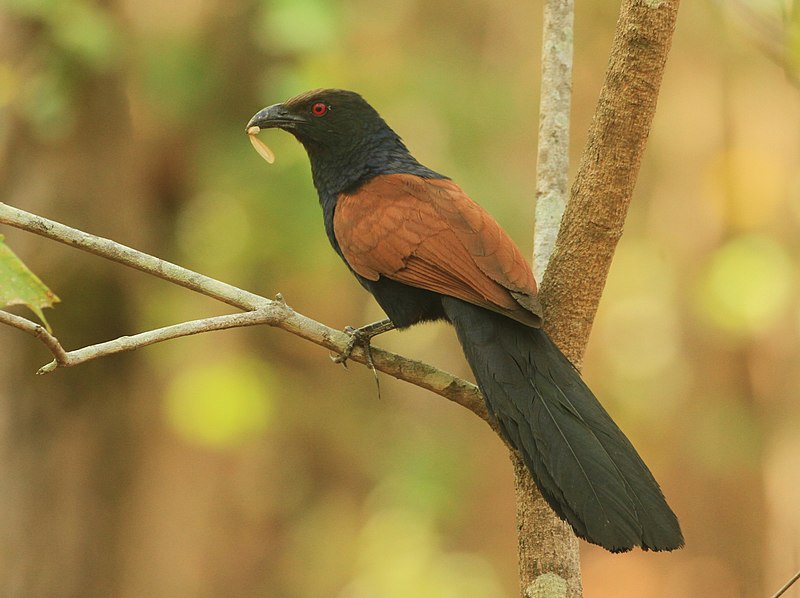
The Greater Coucal is a large, crow-like bird that belongs to the Cuculiformes order. It has a long tail and coppery brown wings.
These birds are found in many habitats across India and Southeast Asia, ranging from jungles to suburban gardens.
They feed on insects as well as small vertebrates such as frogs, lizards or snakes which they capture with their strong beak.
The males have glossy black plumage while females are dark brown above with buff underparts.
During breeding season these birds make loud croaking calls and can often be heard at night when they become active after sundown looking for food sources like termites or grasshoppers between bushes or low branches of trees close by water bodies like rivers, lakes etc.
This species plays an important role in maintaining ecological balance in its habitat by controlling pest populations through predation so it is essential that we protect them from hunting and other threats for future generations to enjoy.
Scientific classification:
| Kingdom | Animalia |
| Phylum | Chordata |
| Class | Aves |
| Order | Cuculiformes |
| Family | Cuculidae |
| Genus | Centropus |
| Species | C. sinensis |
Also Featured In: Common Birds in India, Hong Kong Birds You Need to See
2. Red-Wattled Lapwing
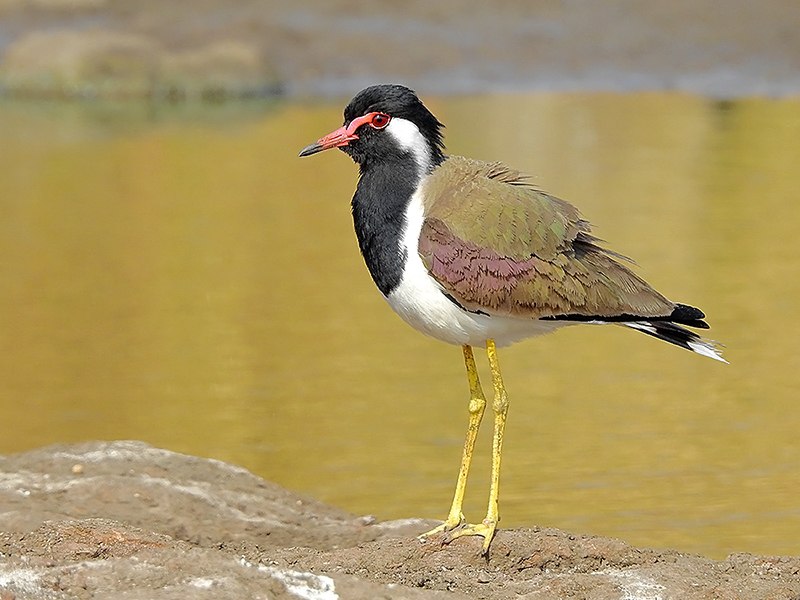
The Red-wattled Lapwing is an Asian bird belonging to the family Charadriidae. It has a distinctive loud call which led to it being nicknamed ‘did he do it’ by locals, due to its sound resembling the phrase.
These birds are usually found on open ground and cannot perch like other lapwings. They have black feathers with white wings, back and tail along with reddish wattles near their eyes that give them their name.
Red-wattled Lapwings feed mainly on insects but also eat some plant matter such as seeds or grains.
During breeding season they form strong pair bonds and make nests in shallow depressions of sand or soil lined with vegetation for incubating eggs during mating season before hatching out young chicks in around 25 days after laying eggs.
Scientific classification:
| Kingdom | Animalia |
| Phylum | Chordata |
| Class | Aves |
| Order | Charadriiformes |
| Family | Charadriidae |
| Genus | Vanellus |
| Species | V. indicus |
Also Featured In: Birds that Live in Uttar Pradesh, Birds of Konkan
3. Asian Koel
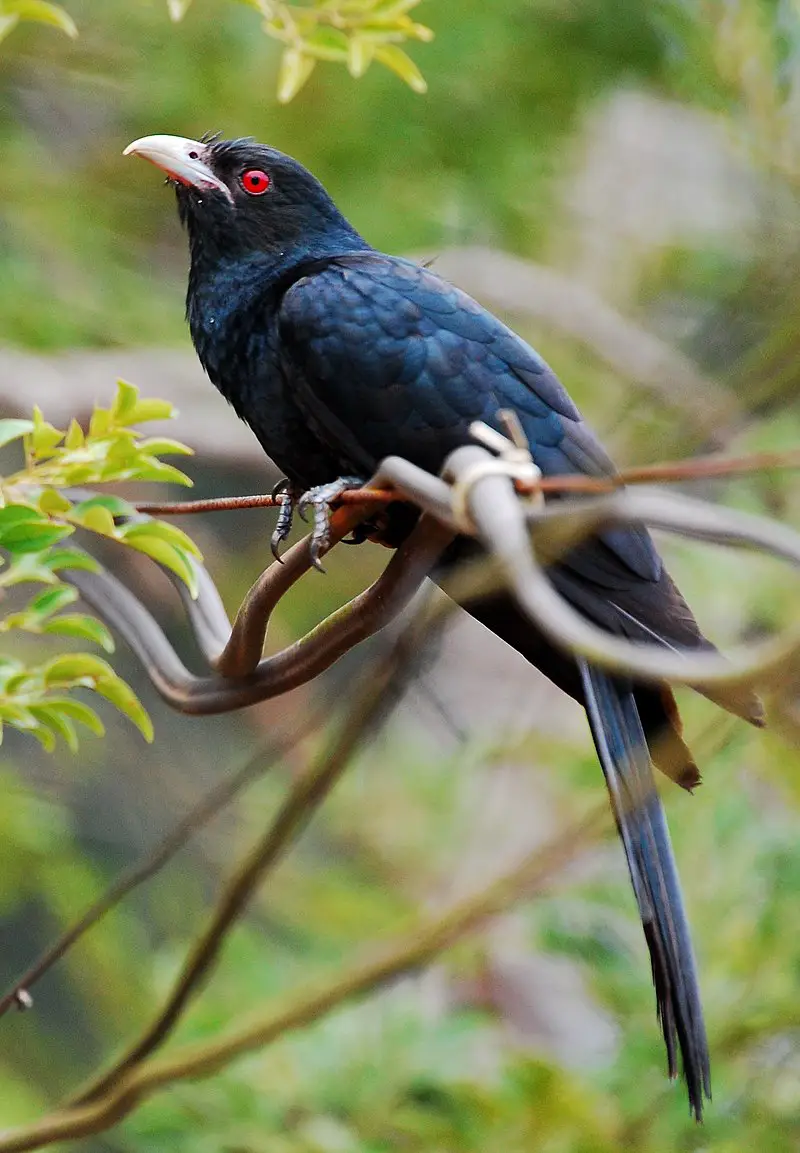
The Asian koel is a member of the Cuculiformes family, found in India, China and Southeast Asia. It shares its range with two closely related species – black-billed koels and Pacific koels.
This bird exhibits brood parasitism; it lays its eggs in nests of other birds, who then unknowingly become foster parents to their young.
Characterised by long tails and glossy feathers that vary from deep blue to greenish-black depending on region, these birds are known for their loud call which can be heard during both day or night time.
They feed mainly on fruits but also take insects when available.
All in all, the Asian Koel is an interesting species that has adapted itself well over many centuries within different ecosystems across Asia.
Scientific classification:
| Kingdom | Animalia |
| Phylum | Chordata |
| Class | Aves |
| Order | Cuculiformes |
| Family | Cuculidae |
| Genus | Eudynamys |
| Species | E. scolopaceus |
Also Featured In: Birds that Live in Tamil Nadu, Common Birds of Mumbai
4. Asian Openbill
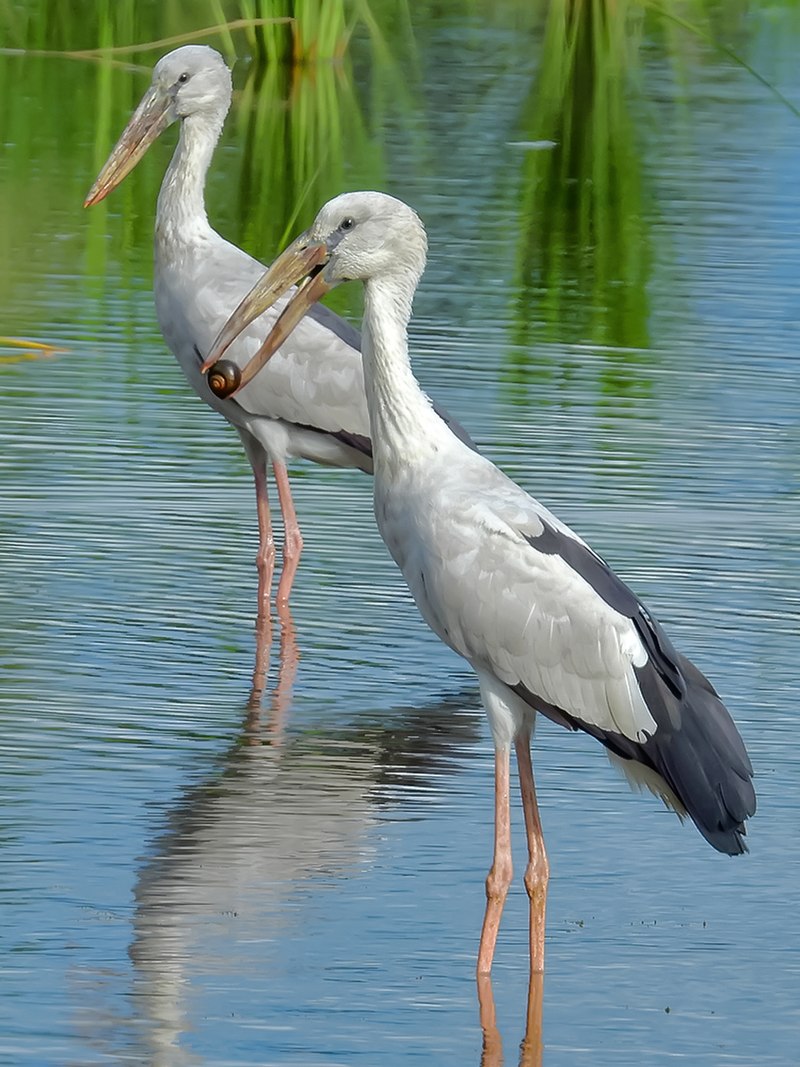
The Asian openbill is a large stork found in the Indian subcontinent and Southeast Asia. It has a greyish or white body, glossy black wings and tail, with an adult having a gap between upper mandible and lower one.
Juveniles don’t have this unique feature but will grow it as they mature.
They feed by wading through shallow water looking for snails, crustaceans and aquatic plants to eat from the surface of mudflats or marshes.
Due to its enormous size (up to 121 cm tall) it makes quite an impressive sight when flying.
Scientific classification:
| Kingdom | Animalia |
| Phylum | Chordata |
| Class | Aves |
| Order | Ciconiiformes |
| Family | Ciconiidae |
| Genus | Anastomus |
| Species | A. oscitans |
Also Featured In: Birds that Live in Rajasthan, Birds That You’ll See in Kaziranga National Park
5. Blue-Faced Malkoha
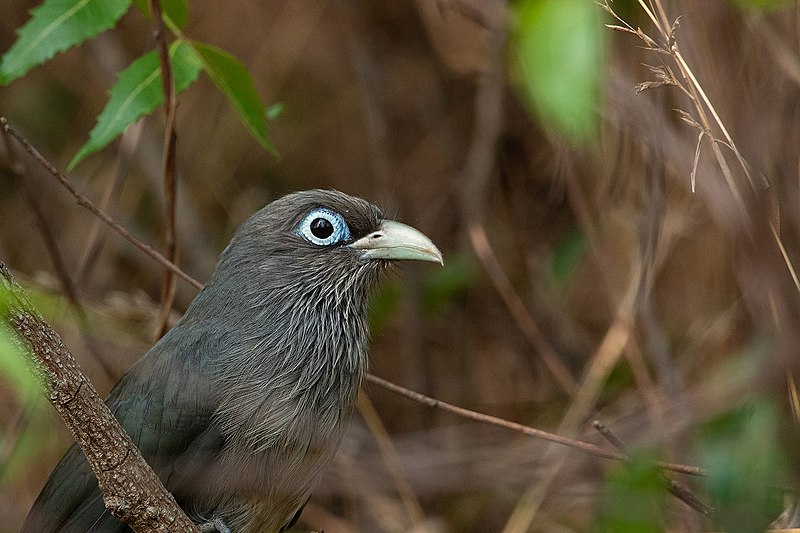
The Blue-faced Malkoha is a beautiful and unique bird which can be found in the scrub and deciduous forests of India and Sri Lanka.
It has an impressive waxy, dark blue-grey plumage on its upperparts with a long tail having graduated white-tipped feathers.
Its throat and chin are darker than other parts of its body but still have spiny pale feathers that branch out from it.
The lower belly usually displays a dusky hue while the wings are brownish grey at their base fading to light brown at tips.
This species also has distinctive green bill giving them their name ‘Small Green Billed’ malkohas’.
They mainly feed on insects or fruits depending upon availability making them omnivorous birds by nature.
Scientific classification:
| Kingdom | Animalia |
| Phylum | Chordata |
| Class | Aves |
| Order | Cuculiformes |
| Family | Cuculidae |
| Genus | Phaenicophaeus |
| Species | P. viridirostris |
Also Featured In: Common Birds of Maharashtra, Birds of Andhra Pradesh
6. Pied Kingfisher
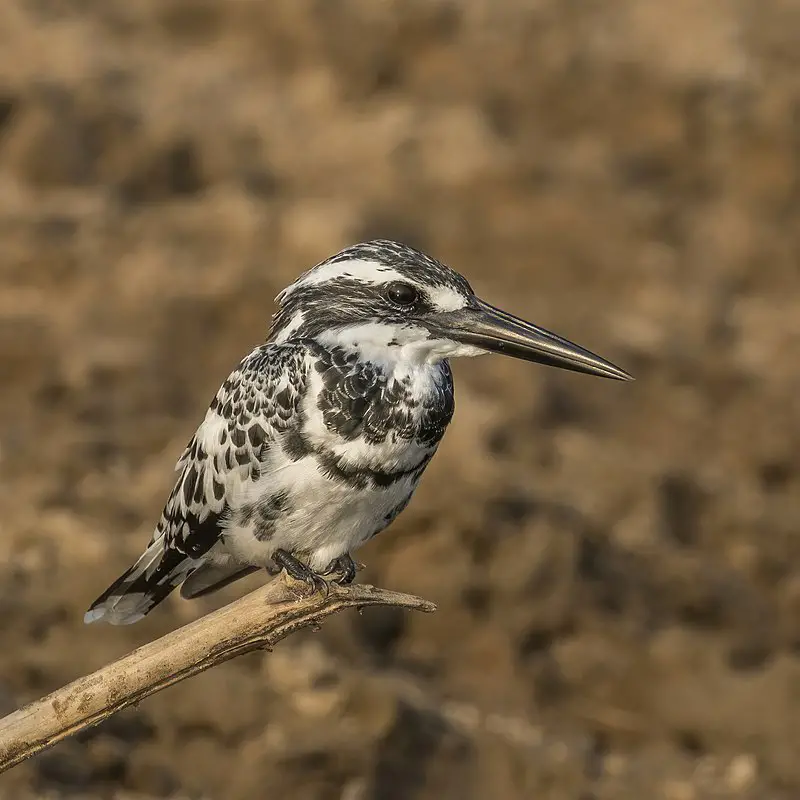
The Pied Kingfisher is a species of water kingfisher found in Africa and Asia. It has black and white plumage, with males sporting a double band across the breast while females have one single band.
This bird makes its presence known by hovering over clear waters before diving for fish – making it easily recognizable.
The diet consists mostly of small aquatic animals such as frogs, crustaceans and insects, but they also consume some plant matter like seeds or fruits occasionally.
The pied kingfisher nests near bodies of water where it can feed off smaller creatures that dwell there; usually in burrows dug into riverbanks or on floating vegetation close to shorelines.
With their distinct colors and behavior patterns these birds make an interesting addition to any wildlife enthusiast’s list.
Scientific classification:
| Kingdom | Animalia |
| Phylum | Chordata |
| Class | Aves |
| Order | Coraciiformes |
| Family | Alcedinidae |
| Subfamily | Cerylinae |
| Genus | Ceryle F. Boie, 1828 |
| Species | C. rudis |
Also Featured In: Native Pakistani Birds, Lebanon Birds Live in Semi-Desert Areas
7. White-Eyed Buzzard
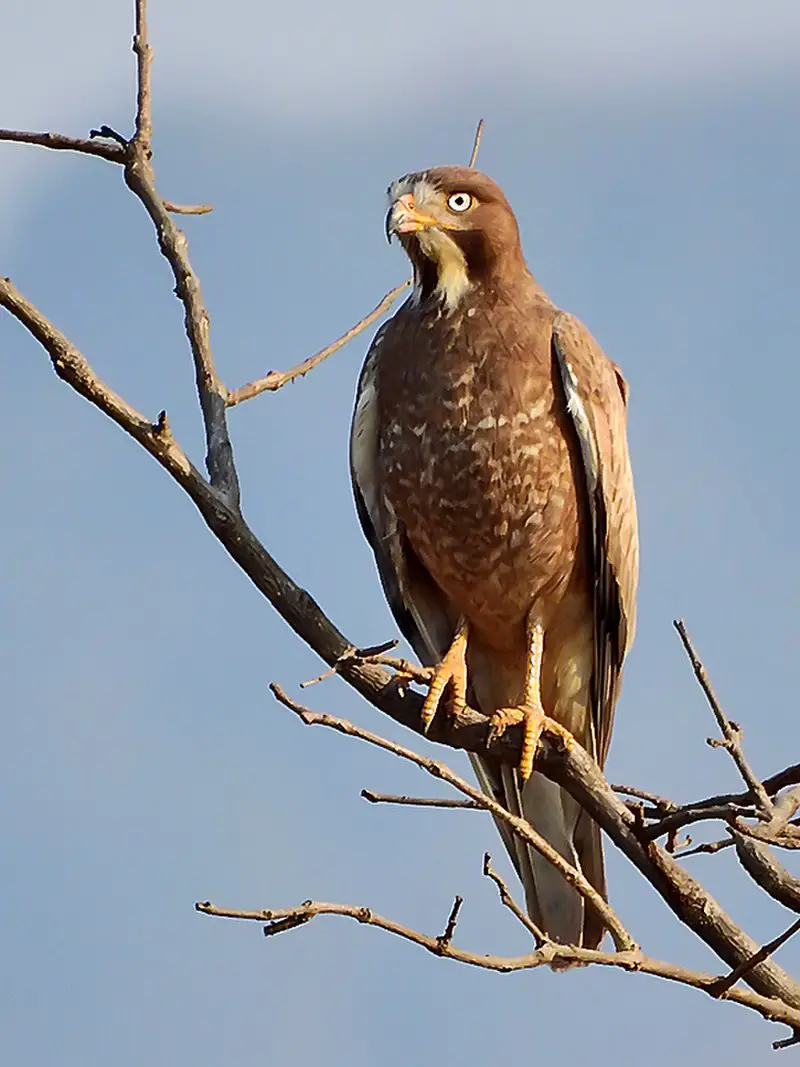
The White-eyed Buzzard is a medium-sized hawk found in South Asia. It has a brown head, rufous tail and distinctive white iris.
Its throat bears a dark mesial stripe bordered by white feathers, while its upper wing holds pale median coverts.
Unlike true buzzards, the underside of their wings don’t have carpal patches.
They feed on small mammals such as rodents and lizards; they also consume snakes and large insects like locusts or grasshoppers.
These birds build stick nests high up in trees for breeding purposes; usually laying one to two eggs at once which are incubated over 4 weeks .
The chicks fledge after about 6 weeks but will stay with their parents until the next breeding season begins when they become independent adults that can live up to 10 years old.
Scientific classification:
| Kingdom | Animalia |
| Phylum | Chordata |
| Class | Aves |
| Order | Accipitriformes |
| Family | Accipitridae |
| Genus | Butastur |
| Species | B. teesa |
Also Featured In: Most Common Birds of Bihar,
8. Northern Storm Petrels
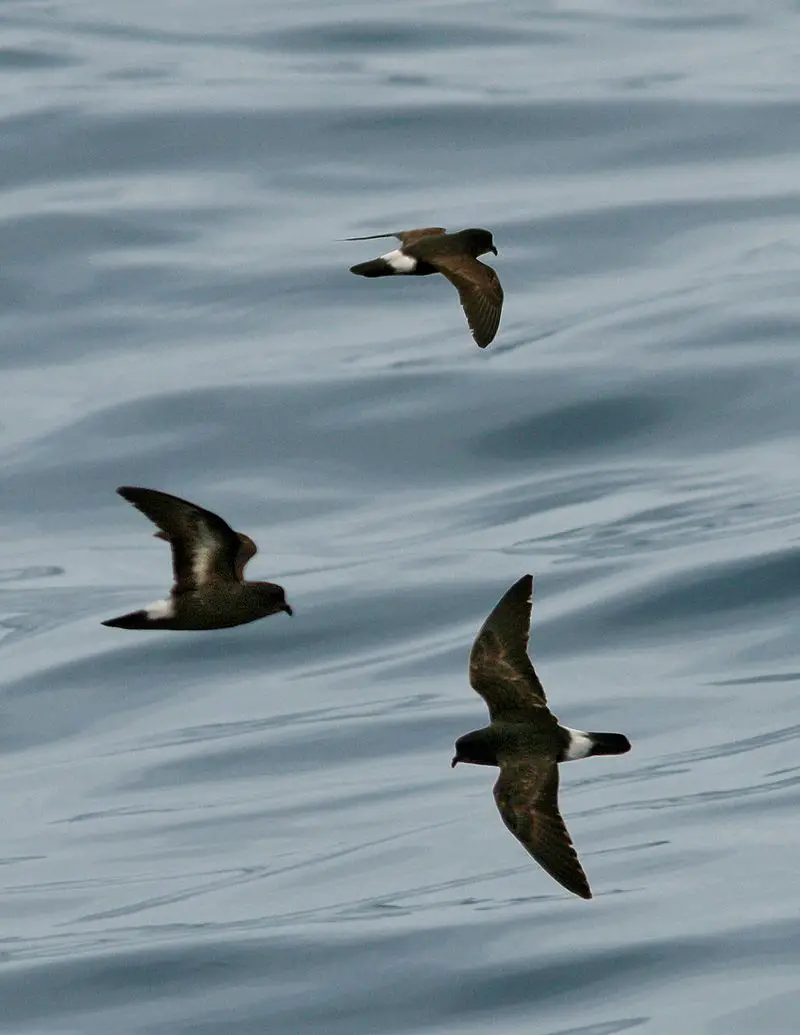
Northern storm petrels are one of the smallest seabirds, inhabiting oceans all over the world.
They have a unique ability to hover over water and pick planktonic crustaceans and small fish from the surface.
Northern storm petrels belong to the genus Hydrobates in family Hydrobatidae, part of Procellariiformes order.
This species was once lumped with austral storm petrel but recent studies show that they weren’t related closely which led them being split into two distinct species now.
These birds can be identified by their dark grey upperparts and wings along with white underparts when seen from afar while feeding on ocean’s surface.
Scientific classification:
| Kingdom | Animalia |
| Phylum | Chordata |
| Class | Aves |
| Order | Procellariiformes |
| Family | Hydrobatidae Mathews, 1912 |
| Genus | Hydrobates F. Boie, 1822 |
Also Featured In: Beautiful Brazilian Birds, Birds of Sweden
9. Bee-Eater

Bee-eaters are one of the most beautiful and vibrant birds in existence. They have a slender body, long wings, down turned bills and their signature elongated central tail feathers which make them instantly recognizable from afar.
Their plumage is incredibly colorful with many shades ranging from blues to greens to reds that glisten when they fly through the air.
These stunning creatures can be found all over Africa, Asia, Southern Europe, Australia and New Guinea where they feed mainly on bees but also other insects like flies or wasps as well as small mammals such as lizards or rodents.
Bee-eaters live in colonies near rivers or wetlands so that they may easily hunt for food while staying close together for safety purposes.
Additionally it allows them to better display their impressive courtship dances during mating season.
Scientific classification:
| Kingdom | Animalia |
| Phylum | Chordata |
| Class | Aves |
| Order | Coraciiformes |
| Family | Meropidae Rafinesque, 1815 |
Also Featured In: Common Nigerian Birds, Common Algerian Birds
10. Coppersmith Barbet
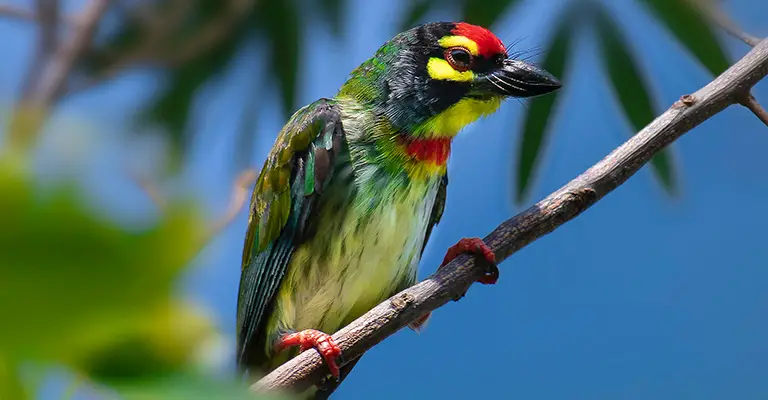
The Coppersmith barbet is an attractive Asian bird, easily recognizable by its bright crimson forehead and throat.
It has a call that sounds like a coppersmith striking metal with a hammer – hence its name.
These birds are found in the Indian subcontinent and parts of Southeast Asia where they build their nests inside trees, carving out holes for themselves.
They can often be seen perched high up on trees or wires during the day as they feed on fruit from nearby branches.
The vibrant colors of these birds make them stand out amongst other species in their habitat.
Scientific classification:
| Kingdom | Animalia |
| Phylum | Chordata |
| Class | Aves |
| Order | Piciformes |
| Family | Megalaimidae |
| Genus | Psilopogon |
| Species | P. haemacephalus |
Also Featured In: Most Common Types of Bangladeshi Birds, Birds that You’ll Find in Kolkata
11. Darters
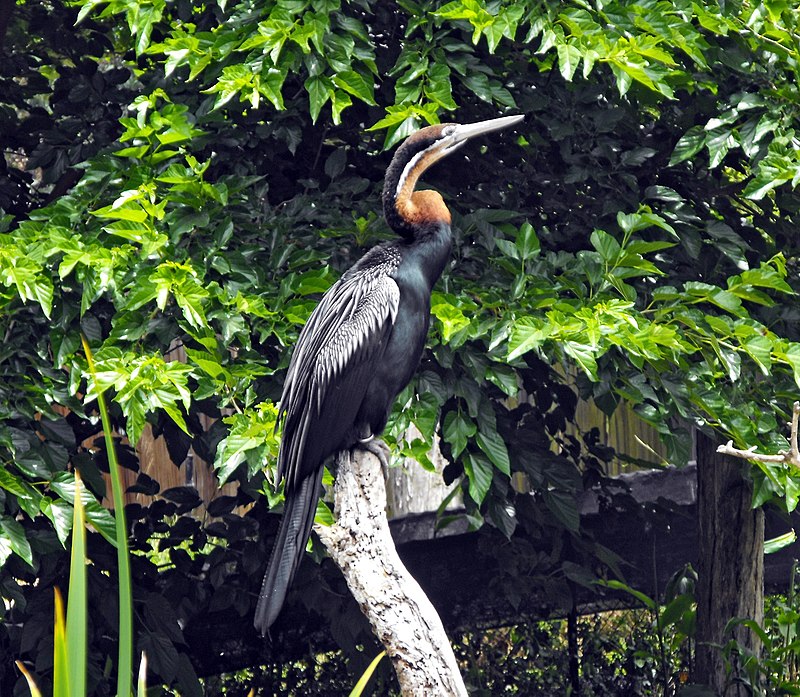
Darters are tropical waterbirds from the family Anhingidae, which includes four species. Three of these species are common and found in multiple locations while one is rarer and classified as near-threatened by IUCN.
Their most notable feature is their long neck which they use to dive into shallow waters for prey such as fish or frogs.
They have a slim body with large wings allowing them to soar high in the sky at great speeds making it difficult for predators to catch them during flight.
Darters also make regular visits to land where they bask in the sun on tree branches or rocky outcroppings.
These birds can be easily identified by their dark feathers, yellowish eyes, and orangey beak – all features that help distinguish them from other birds of similar size and coloration.
Scientific classification:
| Kingdom | Animalia |
| Phylum | Chordata |
| Class | Aves |
| Order | Suliformes |
| Family | Anhingidae Reichenbach, 1849[1] |
| Genus | Anhinga Brisson, 1760 |
Also Featured In: Water Birds Live around Us, South Australian Birds
12. Brahminy Kite
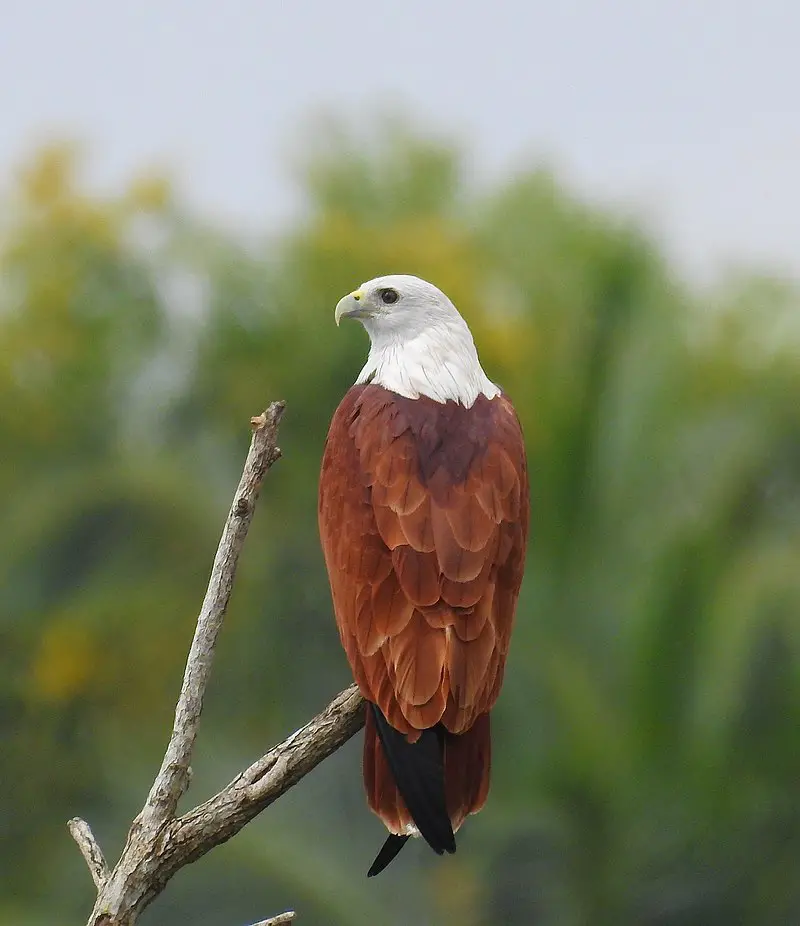
The Brahminy Kite is a majestic bird of prey native to the Indian subcontinent, Southeast Asia and Australia. It was formerly known as the red-backed sea eagle in Australia.
This medium-sized raptor has a distinctive white head with rufous brown feathers covering its body, making it easily recognisable from far away. The wingspan can reach up to 5 feet wide.
Brahminy kites are found mainly on coasts and inland wetlands where they feed mostly on dead fish or carrion left by other animals.
They also hunt for small mammals such as rodents or reptiles like lizards and snakes during dry spells when food sources become scarce.
These birds have adapted well over time and will even scavenge for food near picnic sites or urban areas if need be.
Overall these beautiful creatures are an important part of their local ecosystems which rely heavily upon them for keeping animal populations balanced through natural predation methods instead of manmade ones; this ensures that nature remains healthy so future generations may enjoy it too.
Scientific classification:
| Kingdom | Animalia |
| Phylum | Chordata |
| Class | Aves |
| Order | Accipitriformes |
| Family | Accipitridae |
| Genus | Haliastur |
| Species | H. indus |
Also Featured In: Birds that Live around Brisbane, Birds that Charles Darwin Studied
13. Black-Capped Kingfisher
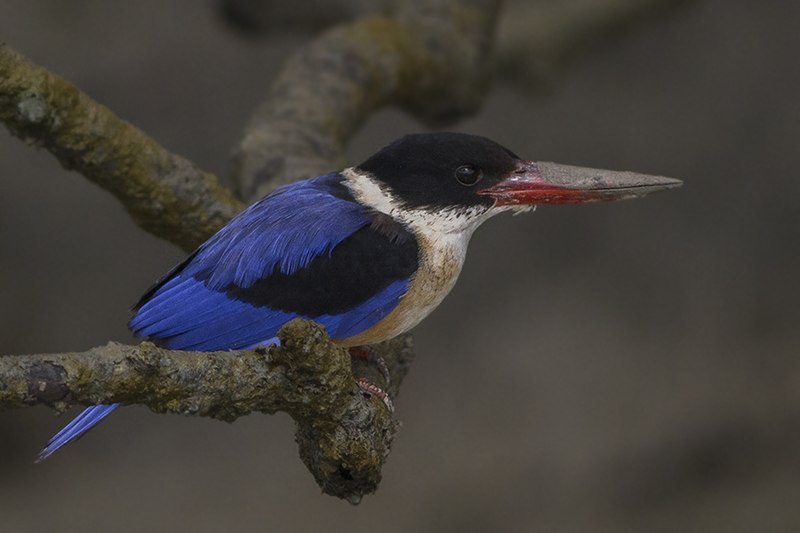
The Black-capped Kingfisher is a beautiful species of tree kingfishers found in tropical Asia from India east to China, Korea and Southeast Asia.
Its striking features include its black cap that contrasts with its bright blue back, wings and tail.
It has white underparts which makes it easily identifiable when perched atop trees or flying above the ground searching for food.
During winter months some northern populations migrate south seeking warmer climates such as Sri Lanka, Thailand, Borneo and Java.
The diet of this bird consists mainly of insects but may also feed on small reptiles like lizards or snakes if available.
They can be seen generally near water bodies where they hunt their prey by diving into the waters from a high perch.
Scientific classification:
| Kingdom | Animalia |
| Phylum | Chordata |
| Class | Aves |
| Order | Coraciiformes |
| Family | Alcedinidae |
| Subfamily | Halcyoninae |
| Genus | Halcyon |
| Species | H. pileata |
Also Featured In: Birds that Migrate to Sri Lankan, Most Common Birds of Ko Samui
14. Blue-Eared Kingfisher
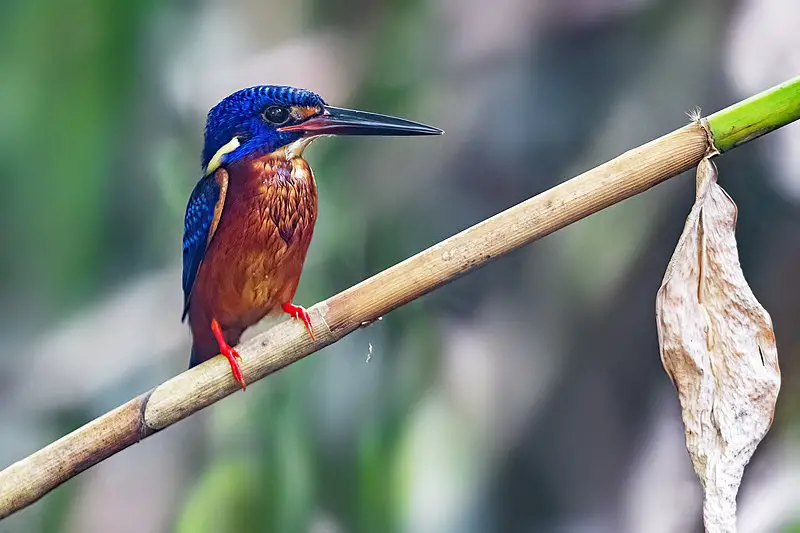
The Blue-eared Kingfisher is a beautiful species of bird found mainly in the dense forests across India and Southeast Asia.
Its distinguishing features include its darker crown, dark rufous underparts, and lack of the typical red ear stripe seen on other kingfishers such as Alcedo atthis which usually inhabit more open environments.
There are different subspecies identified by researchers due to slight variations in size or colouration present within this species.
The Blue-eared Kingfisher feeds mostly on small fish it catches while hunting along slow moving streams near shaded areas that provide plenty of cover from predators.
Not much else is known about these beautiful birds but they remain an important part of their local ecosystems.
Scientific classification:
| Kingdom | Animalia |
| Phylum | Chordata |
| Class | Aves |
| Order | Coraciiformes |
| Family | Alcedinidae |
| Subfamily | Alcedininae |
| Genus | Alcedo |
| Species | A. meninting |
15. Asian Green Bee-Eater
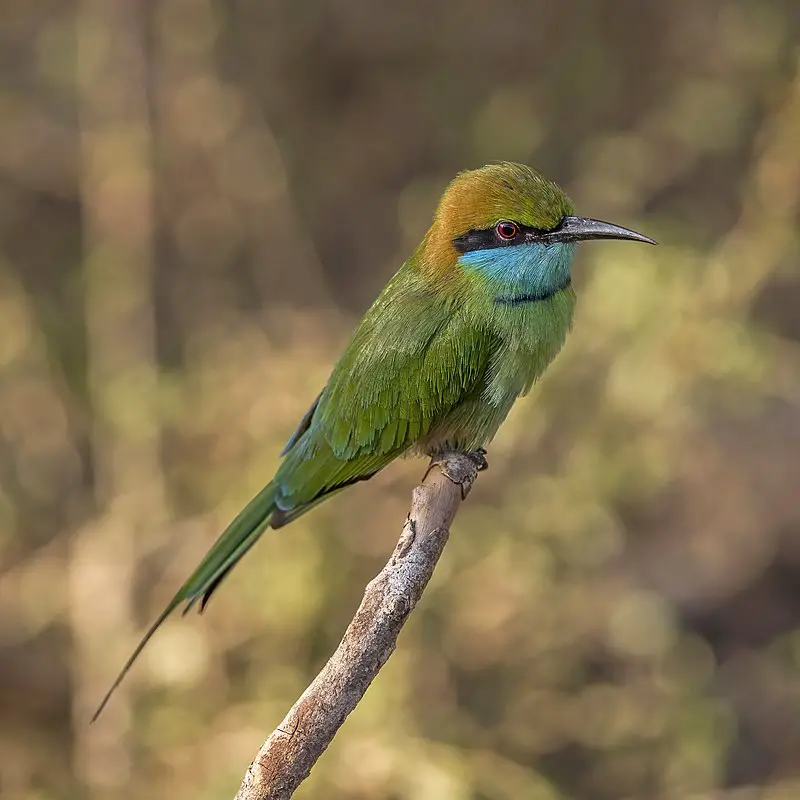
The Asian green bee-eater is a near passerine bird in the bee-eater family. It’s native to parts of Asia, stretching from Iran all the way over to Vietnam.
These birds are resident but tend to migrate seasonally and can also be found in Africa and Arabia.
They have bright green feathers on their upperparts with yellowish underparts, making them easy to spot when they’re flying around looking for insects like bees, wasps and dragonflies.
They usually nest burrows dug into sandy ground or riverbanks where they lay up to five eggs at once.
The Asian green bee-eater is an exciting species that has been popular among ornithologists since its discovery hundreds of years ago.
Scientific classification:
| Kingdom | Animalia |
| Phylum | Chordata |
| Class | Aves |
| Order | Coraciiformes |
| Family | Meropidae |
| Genus | Merops |
| Species | M. orientalis |
Also Featured In: Most Common Madhya Pradesh Birds,
16. Brown Wood Owl
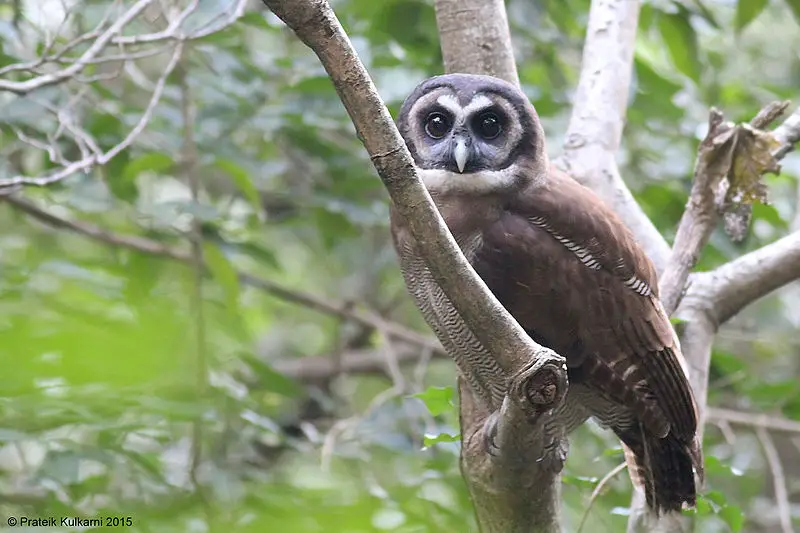
The Brown Wood Owl is a beautiful bird native to parts of Asia. It measures 45-57 cm in length and has unicolored upperparts that vary from light brown to dark gray, while its underparts are barred with pale streaks.
Its head features large yellow eyes and prominent ear tufts which give it an impressive appearance. This species is part of the typical owl family (Strigidae) and belongs to the genus Strix.
The habitat of this species includes dense forests, woodlands, mangroves as well as plantations across India, Bangladesh Sri Lanka Indonesia Taiwan and south China where they breed all year round.
An interesting fact about these owls is that their diet consists mainly of rodents such as rats or mice making them important for controlling rodent populations in agricultural areas.
Scientific classification:
| Kingdom | Animalia |
| Phylum | Chordata |
| Class | Aves |
| Order | Strigiformes |
| Family | Strigidae |
| Genus | Strix |
| Species | S. leptogrammica |
17. Brown Fish Owl
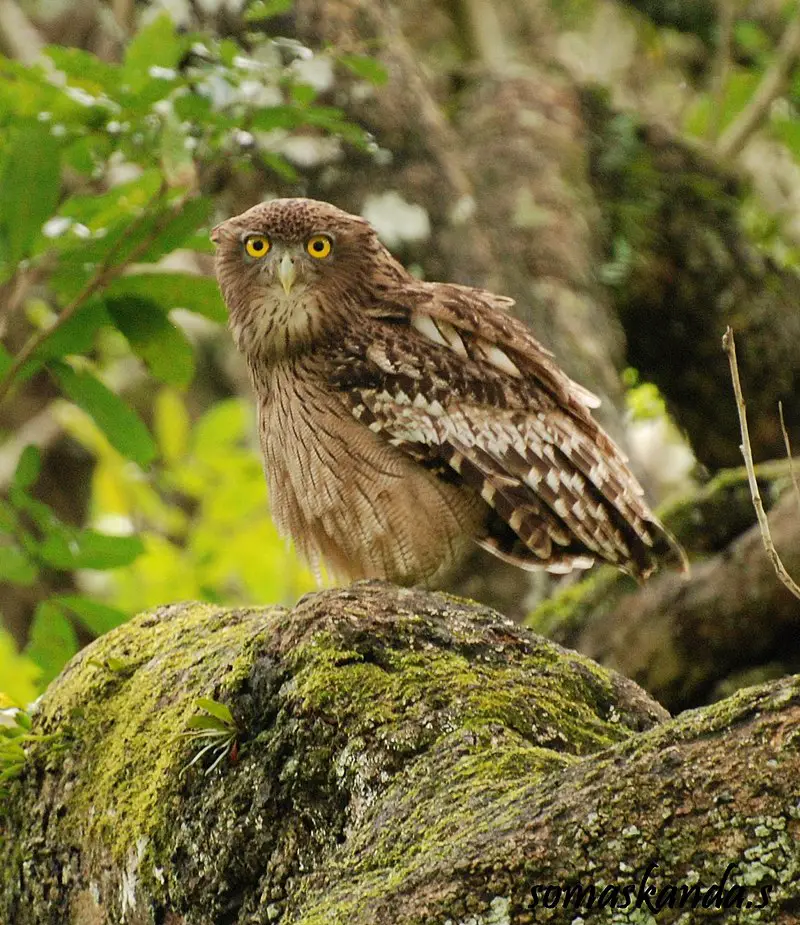
The Brown Fish Owl is a species of owl found in Turkey, South and Southeast Asia. It inhabits forests and wooded wetlands with its wide distribution leading to it being categorized as least concern on the IUCN Red List.
Of all four living fish owl species, this one is the most abundant, widespread and studied. Its diet consists mainly of fish but also small mammals or reptiles when available.
They usually hunt from perches near water sources waiting for their prey before swooping down to capture them using powerful talons between dusk until dawn.
These birds are monogamous with pairs staying together throughout the year while raising their young which hatch after 30 days of incubation by both parents in tree hollows or rock crevices close to streams or lakesides where they can easily find food for themselves and their offspring
Scientific classification:
| Kingdom | Animalia |
| Phylum | Chordata |
| Class | Aves |
| Order | Strigiformes |
| Family | Strigidae |
| Genus | Ketupa |
| Species | K. zeylonensis |
18. Common Tailorbird
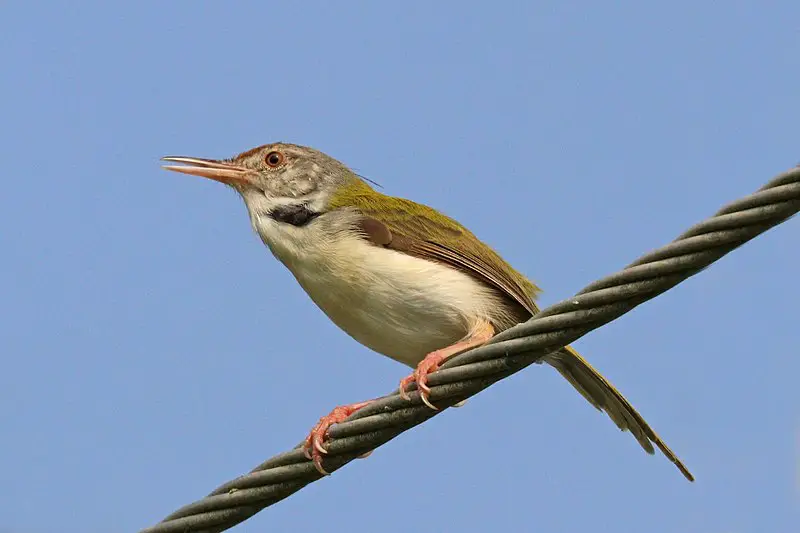
The Common Tailorbird is a songbird found across tropical Asia, popular for its unique nests made of leaves “sewn” together.
It was immortalized by Rudyard Kipling in his Jungle Book as Darzee and can often be seen in urban gardens.
Though shy birds that are usually hidden within vegetation, their loud calls give away their presence.
They are distinctive with a brownish plumage on the upperparts and paler gray underparts; white throats speckled black mark them out from other similar species.
They feed mainly on insects such as spiders, caterpillars and grasshoppers but will also eat fruit when available.
Breeding season begins around March or April with males singing to claim territories before beginning to weave intricate leafy structures for nesting sites – an amazing feat.
All in all these delightful little birds make wonderful additions to any garden setting – just remember not to get too close.
Scientific classification:
| Kingdom | Animalia |
| Phylum | Chordata |
| Class | Aves |
| Order | Passeriformes |
| Family | Cisticolidae |
| Genus | Orthotomus |
| Species | O. sutorius |
Also Featured In: Urban Birds of Hong Kong, Birds That Live In Phuket Island
19. Collared Kingfisher
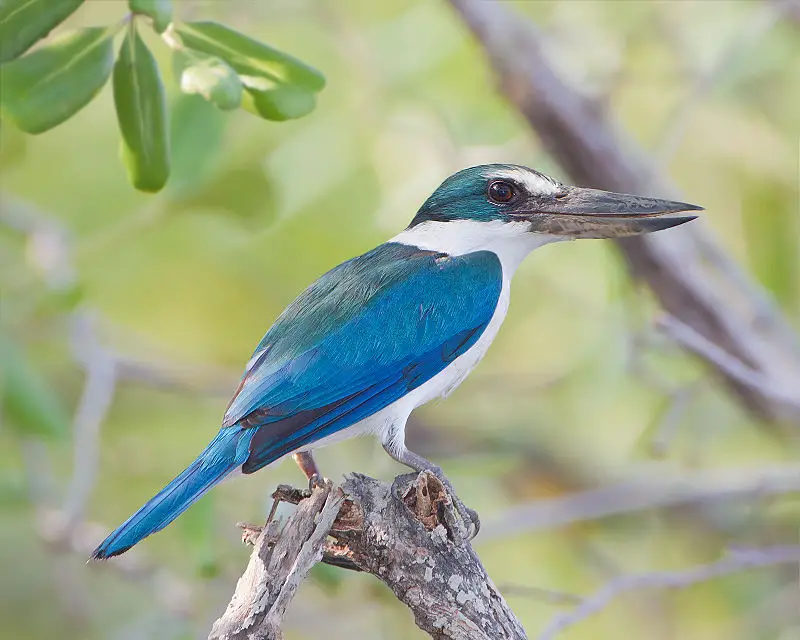
The Collared kingfisher is a medium-sized bird belonging to the Halcyoninae subfamily of tree kingfishers. It has a distinctive white collar and black mask that set it apart from other species in its family.
Its wide range extends from the Red Sea across southern Asia to Polynesia, making it one of the most widespread birds in the region.
The male and female collared kingfisher both have blue wings with dark barring, while juveniles are brownish grey with duller markings.
They feed mainly on fish, but can also be seen consuming crustaceans, reptiles, insects and small mammals when available.
This species nests inside cavities or tunnels near riverbanks or swamps created by their powerful bills; they often dig these themselves if there aren’t any existing ones nearby.
Despite being abundant throughout much of its range, this beautiful bird’s population numbers appear to be declining due to habitat destruction caused by human activity such as deforestation and development projects along riversides which provide important nesting sites for them.
Scientific classification:
| Kingdom | Animalia |
| Phylum | Chordata |
| Class | Aves |
| Order | Coraciiformes |
| Family | Alcedinidae |
| Subfamily | Halcyoninae |
| Genus | Todiramphus |
| Species | T. chloris |
Also Featured In: Birds of the Philippines, Common Philippines Birds
20. Pittas
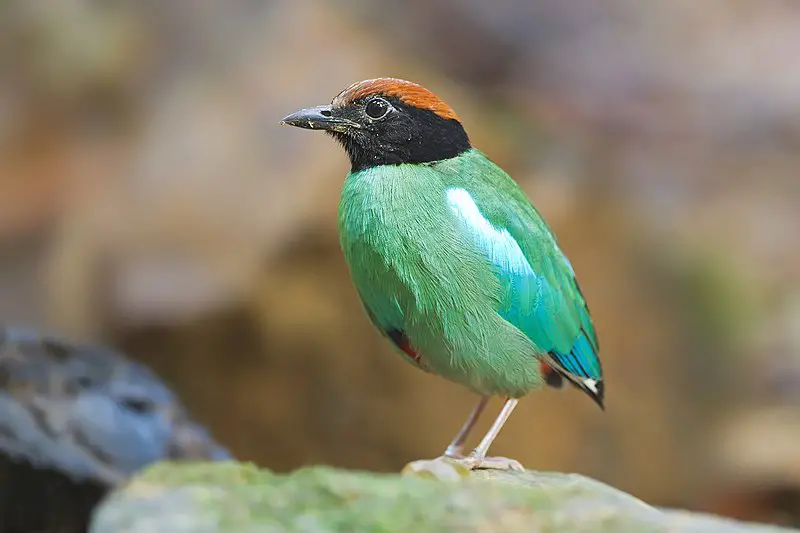
Pittas are a family of passerine birds known for their vibrant colors and unique appearance. They can be found in Asia, Australasia and Africa with around 40 to 42 species existing today.
These Old World suboscines have closest relatives among other bird genera such as Smithornis and Calyptomena.
Pittas inhabit tropical forests where they hop from branch to branch searching for insects or worms on the ground below them.
Their feathers are stunningly colored with combinations of blue, green, copper, purple or even yellow making them stand out amongst others in the forest canopy.
Scientific classification:
| Kingdom | Animalia |
| Phylum | Chordata |
| Class | Aves |
| Order | Passeriformes |
| Suborder | Tyranni |
| Infraorder | Eurylaimides |
| Superfamily | Pittoidea |
| Family | Pittidae Authority disputed.[a] |
Also Featured In: Asian Birds, Queensland Birds You Should Know
21. Blue-Tailed Bee-Eater
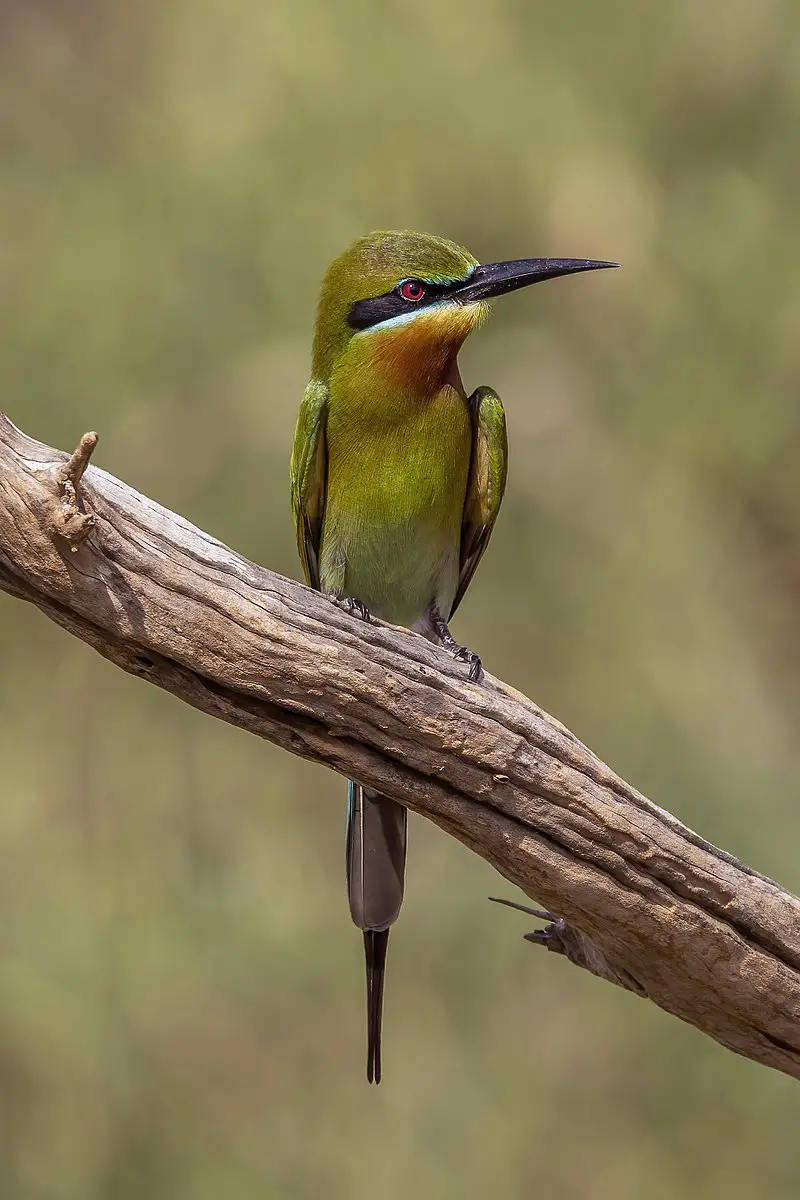
The Blue-tailed Bee-eater is a stunning bird found in South and Southeast Asia. This vibrant species has an iridescent blue tail, green back, yellow chest and white throat that stands out against the bright sky.
It feeds mainly on bees, wasps and other flying insects which it catches using its sharp beak while swooping through the air with remarkable agility.
The bee-eater typically nests by tunneling into loamy sand banks near rivers or streams to create burrows for their eggs.
During migration season they are often seen in large flocks soaring gracefully across the landscape seeking food sources before settling down in colonies during breeding season.
With its beautiful colours and graceful flight this impressive avian beauty captivates anyone lucky enough to see it up close.
Scientific classification:
| Kingdom | Animalia |
| Phylum | Chordata |
| Class | Aves |
| Order | Coraciiformes |
| Family | Meropidae |
| Genus | Merops |
| Species | M. philippinus |
22. Crab-Plover
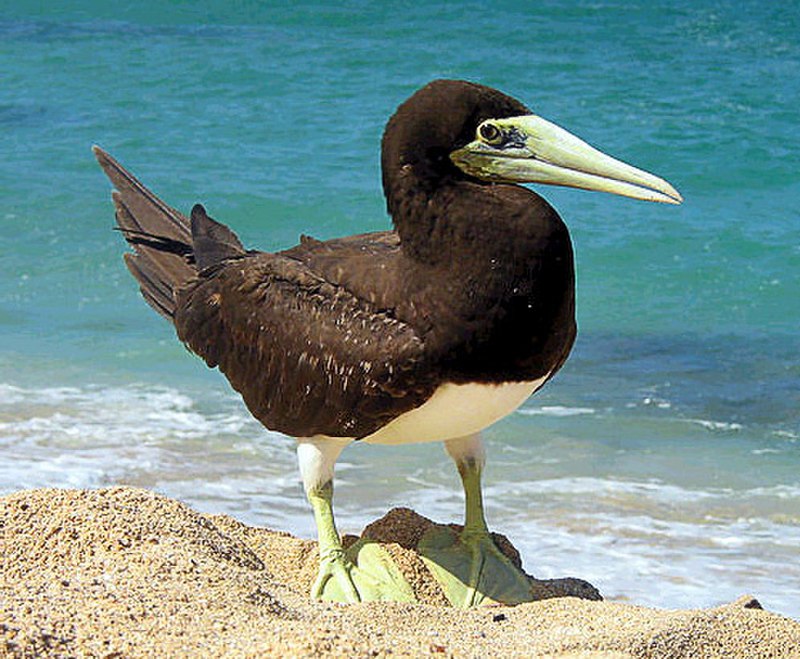
The crab-plover is an exceptional bird which belongs to its own family, Dromadidae. It appears to be closely related to the waders and other Charadriiformes such as auks, gulls and thick-knees.
This species of bird has a unique look; it is white with black markings on its head and wings. Its long bill helps them dig for food in sand or mudflats.
They can also fly up into the air when disturbed by predators or people too close for comfort.
The crab plover spends most of its life near beaches where they feed on crabs, fish eggs and small insects found there.
These birds are highly social during breeding season but solitary at other times throughout their annual cycle making them difficult creatures to spot out in the wild but well worth trying.
Scientific classification:
| Kingdom | Animalia |
| Phylum | Chordata |
| Class | Aves |
| Order | Charadriiformes |
| Suborder | Lari |
| Family | Dromadidae GR Gray, 1840 |
| Genus | Dromas Paykull, 1805 |
| Species | D. ardeola |
Also Featured In: Egyptian Birds, Birds That Live in Iraq
23. Procellariidae

Procellariidae is a diverse family of seabirds belonging to the bird order Procellariiformes.
These birds are commonly referred to as tubenoses and include fulmarine petrels, gadfly petrels, diving petrels, prions, and shearwaters.
They range in size from the small storm-petrel which measures around 18cm long to the giant albatross which can reach up to 3 meters in length.
Generally found near oceans or coasts where they feed on fish as well as squid and other marine life depending on species.
Many procellariids will also nest inland during breeding season before returning back out at sea for most of their lives.
Their wings have specially adapted feathers that give them incredible gliding abilities allowing them literally fly with minimal effort over vast distances across oceanic regions
Scientific classification:
| Kingdom | Animalia |
| Phylum | Chordata |
| Class | Aves |
| Order | Procellariiformes |
| Family | Procellariidae Leach, 1820 |
Also Featured In: Most common Birds in France, Most Common Romanian Birds
24. Spoonbills
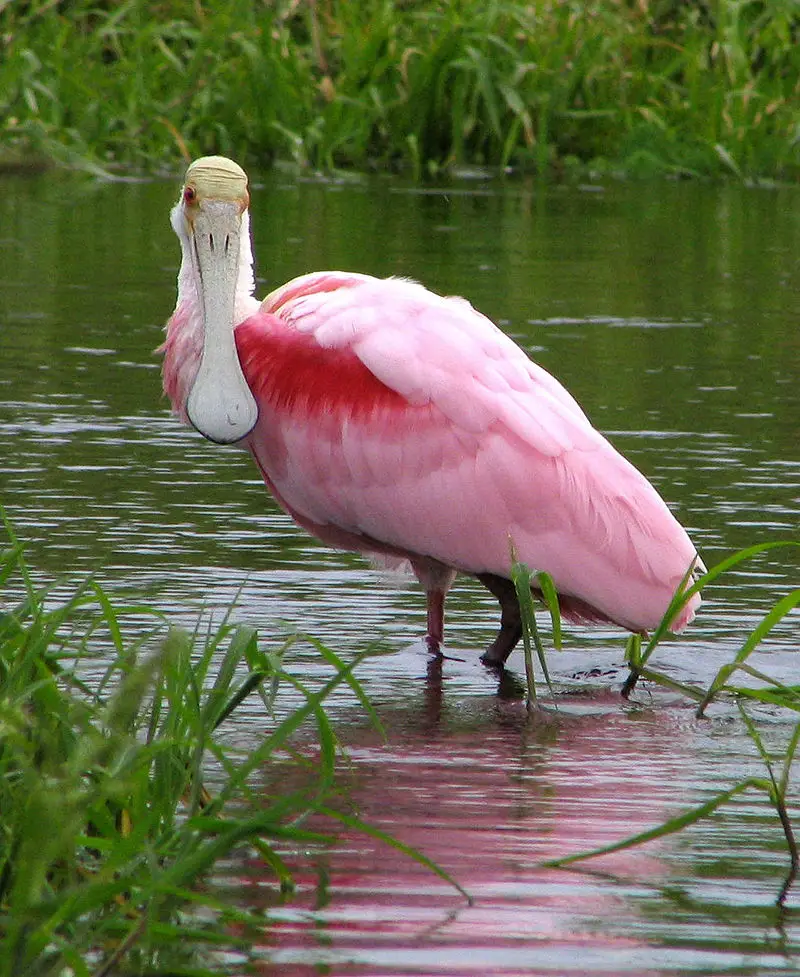
Spoonbills are large wading birds belonging to the genus Platalea. Characterized by their long legs and distinctive spoon-shaped beaks, these birds can be found all over the world except Antarctica.
The name of this genus derives from Ancient Greek meaning “broad”, referring to their bill’s shape.
There are six species of Spoonbill recognized – though they usually form a single group, sometimes it is divided into three genera.
These graceful creatures feed mainly on small aquatic organisms such as insects and fish which they catch with an open-mouth technique while sweeping through shallow waters in search for food.
They typically breed near water bodies during springtime when there’s plenty of food available around them.
Scientific classification:
| Kingdom | Animalia |
| Phylum | Chordata |
| Class | Aves |
| Order | Pelecaniformes |
| Family | Threskiornithidae |
| Subfamily | Plataleinae |
| Genus | Platalea Linnaeus, 1758 |
Also Featured In: Birds of South African, Birds Found in Hungary
25. Black-Headed Ibis
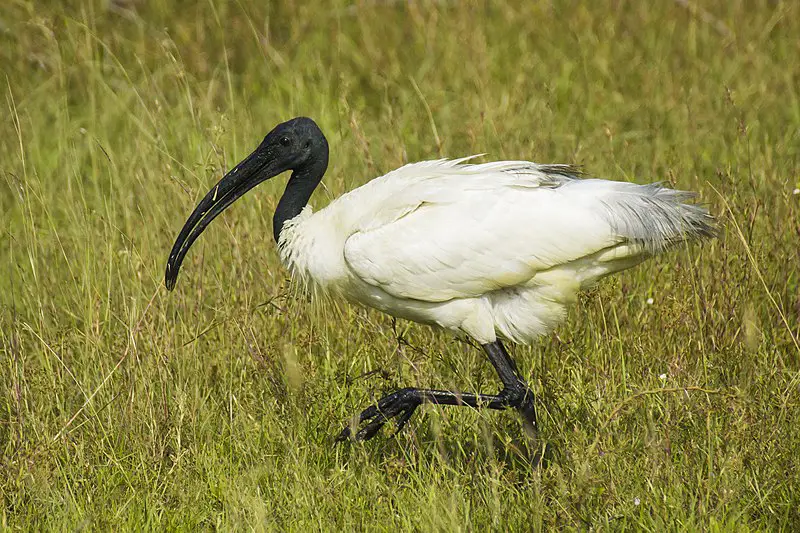
The Black-headed ibis is a majestic wading bird that can be found in areas of South and Southeast Asia, stretching from India to Japan.
It has an overall white plumage, with the most striking feature being its distinctive black neck.
These birds feed mainly on aquatic insects, small fish and frogs which they catch while walking slowly along shallow waters or sweeping their bill through them. They also eat worms, lizards and snails as well as some vegetation such fruits, grains etc..
Despite their wide range across different regions within South/Southeast Asia due to human activities like urbanisation and agricultural expansion.
This species’ population is decreasing at alarming rates making it critically endangered in certain parts of its natural habitat.
Scientific classification:
| Kingdom | Animalia |
| Phylum | Chordata |
| Class | Aves |
| Order | Pelecaniformes |
| Family | Threskiornithidae |
| Genus | Threskiornis |
| Species | T. melanocephalus |
Also Featured In: Birds of Myanmar, Black And White Birds You Don’t Know About
26. Black-Hooded Oriole
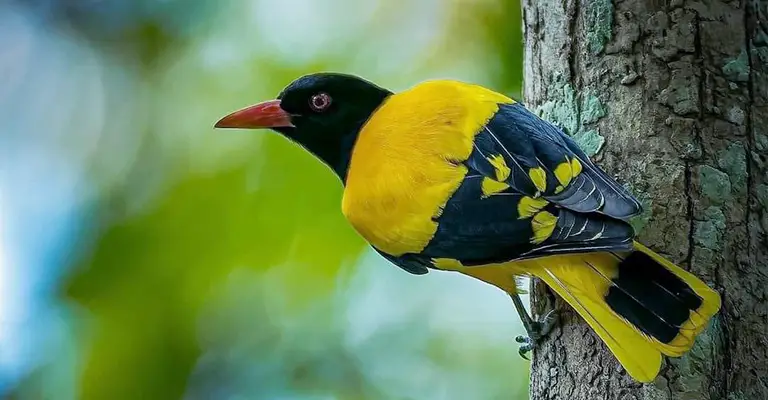
The Black-hooded Oriole is a beautiful and unique bird found in tropical southern Asia. It has black feathers on its head, giving it the name “black hooded”.
Its diet consists of insects, fruit, especially figs which can be found in the tree canopy where they spend most of their time. They build nests high up on trees to lay their eggs – usually two per nest.
The orioles are active during daybreak and nightfall when they search for food or mates. Their bright colors make them noticeable even from afar making them an interesting sight for any nature lover with a keen eye.
Scientific classification:
| Kingdom | Animalia |
| Phylum | Chordata |
| Class | Aves |
| Order | Passeriformes |
| Family | Oriolidae |
| Genus | Oriolus |
| Species | O. xanthornus |
Also Featured In: Common Birds Found in Nepal, Birds that You’ll Find in Kruger national park
27. Bar-Winged Flycatcher-Shrike
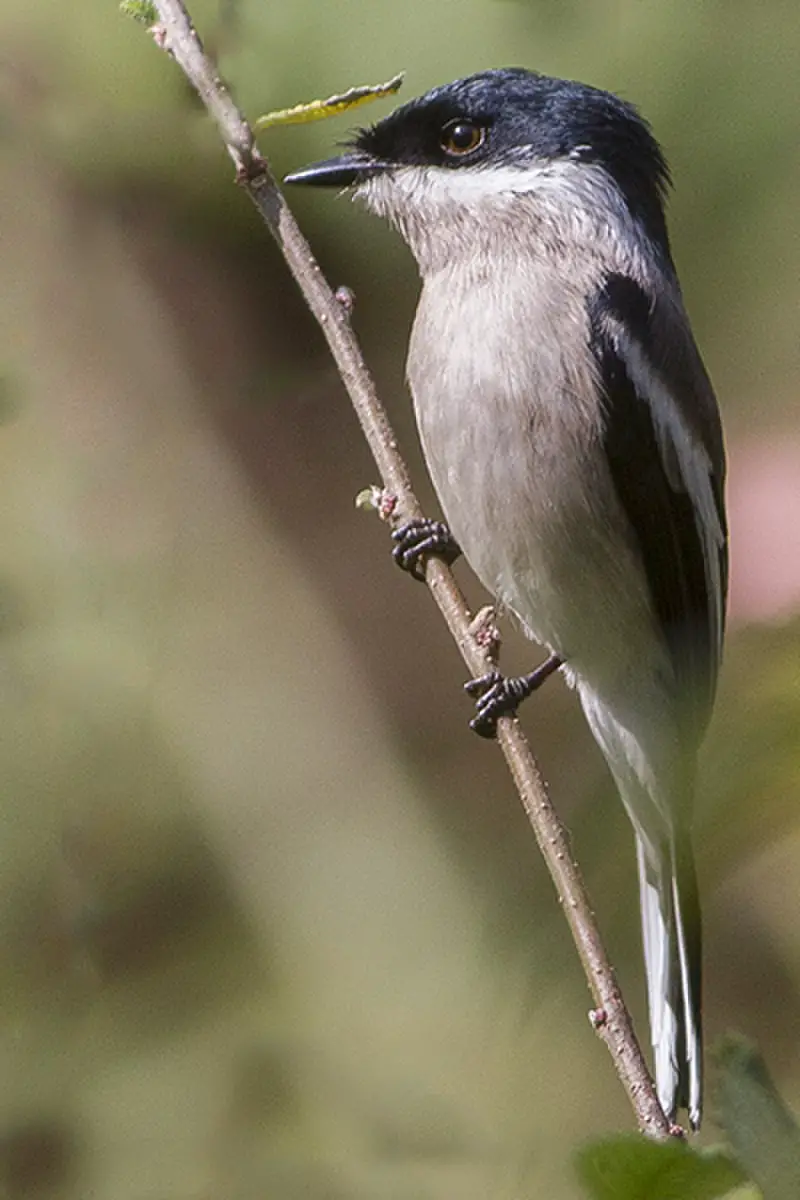
The Bar-winged Flycatcher-Shrike is a small passerine bird found in the forests of tropical southern Asia, ranging from the Himalayas and hills of India to Indonesia.
These birds inhabit mid-canopy levels in the forest, often joining mixed species flocks while they search for food.
With its distinctive pattern of black and white plumage on its head and wings, this flycatcher can be easily identified by experienced bird watchers.
They are mainly insectivorous birds that feed upon insects such as moths, beetles and flies which they capture using their sharp bill or talons during flight.
The bar-winged flycatcher has adapted well to life in these woodlands with an agile nature allowing it to navigate quickly through dense foliage when searching for prey or evading predators.
Scientific classification:
| Kingdom | Animalia |
| Phylum | Chordata |
| Class | Aves |
| Order | Passeriformes |
| Family | Vangidae |
| Genus | Hemipus |
| Species | H. picatus |
Also Featured In: Birds that Live in Kuala Lumpur, Birds that Commonly Found in Andhra Pradesh
28. Black-Winged Kite
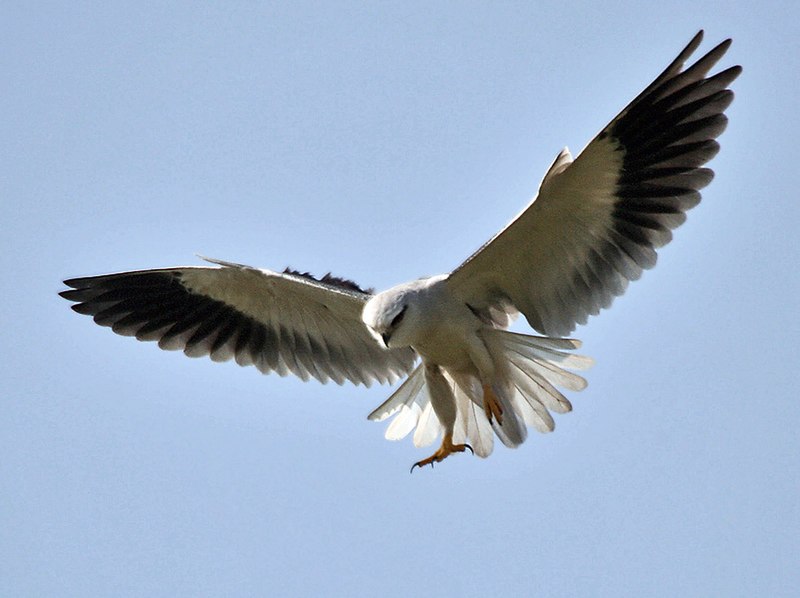
The Black-winged Kite is a small, diurnal bird of prey in the Accipitridae family. It can be found throughout Palearctic and Afrotropical regions.
This species stands out from other birds of prey due to its unique ability to hover over open grasslands like kestrels do.
Its wings are black with white patches on them while its body has gray feathers, giving it a distinct look from the rest of the accipiters.
The underside is mostly white with some barring near the tail area that helps distinguish this species from others.
They feed mainly on insects but will also eat rodents, lizards and even snakes if they come across one.
Because these birds hunt during daylight hours, their diet changes as time passes by – making them quite adaptive hunters.
Scientific classification:
| Kingdom | Animalia |
| Phylum | Chordata |
| Class | Aves |
| Order | Accipitriformes |
| Family | Accipitridae |
| Genus | Elanus |
| Species | E. caeruleus |
Also Featured In: Birds Of Côte d’Ivoire, Bulgarian Birds
29. Common Emerald Dove
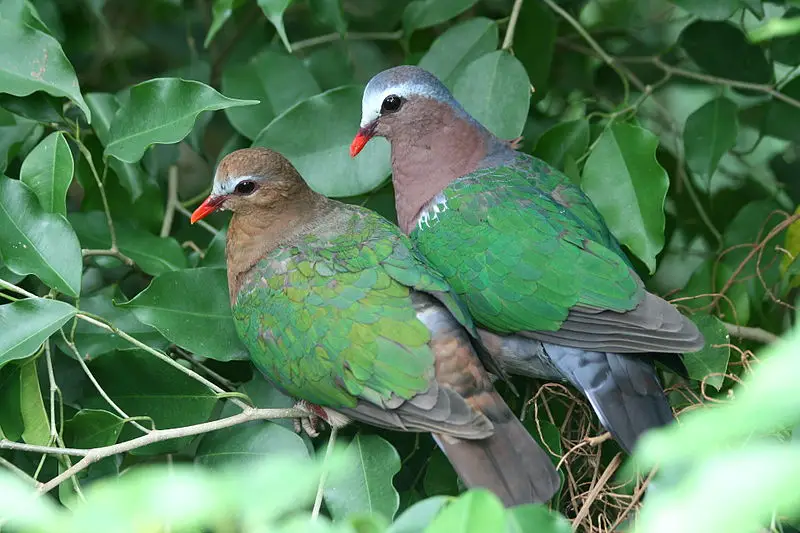
The Common Emerald Dove is a beautiful bird that can be found in tropical and subtropical parts of the Indian Subcontinent and Southeast Asia.
Its distinctive features include its grey-capped head, while its wings are an emerald green colour.
It has also earned itself the nickname “green dove” or “green-winged pigeon”. This species plays an important role in Tamil Nadu’s ecology, which makes it fitting for them to have named it their state bird.
The Pacifric Emerald Dove is closely related to this species but they differ slightly in appearance and habitat preferences; however both make great pets due to being gentle by nature.
Scientific classification:
| Kingdom | Animalia |
| Phylum | Chordata |
| Class | Aves |
| Order | Columbiformes |
| Family | Columbidae |
| Genus | Chalcophaps |
| Species | C. indica |
Also Featured In: Birds in Sri Lanka, Coastal Birds That Live around Miyako-jima
30. Frigatebird
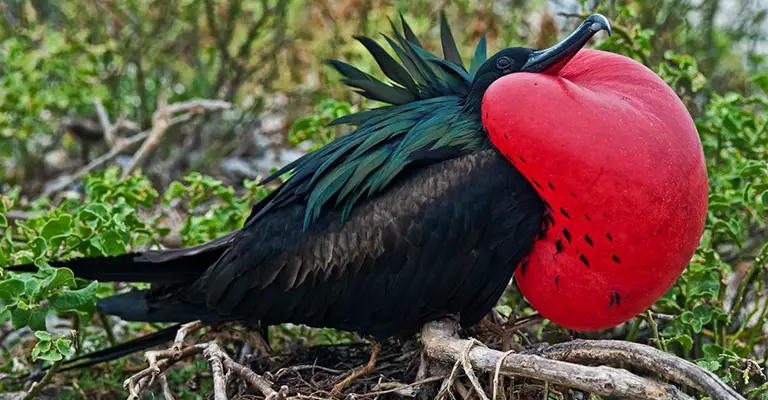
Frigatebirds are a beautiful and mysterious family of seabirds, found in all tropical and subtropical oceans. The five extant species have glossy black plumage, long forked tails, and lengthy hooked bills.
During the breeding season males display a bright red gular pouch which they inflate to attract mates. Females have white underbellies year-round giving them an elegant contrast against their darker feathers.
They spend most of their lives soaring with minimal effort over warm ocean waters seeking food such as fish or squid taken from the surface or plucked out of midair by other birds.
Frigatebirds often nest on isolated islands due to lack of predators yet still manage to travel incredibly large distances between feeding grounds every day making them truly remarkable creatures.
Scientific classification:
| Kingdom | Animalia |
| Phylum | Chordata |
| Class | Aves |
| Order | Suliformes |
| Family | Fregatidae Degland & Gerbe, 1867 |
| Genus | Fregata Lacépède, 1799 |
Also Featured In: Birds of Ecuador, Flocks Birds around Us
31. Drongos
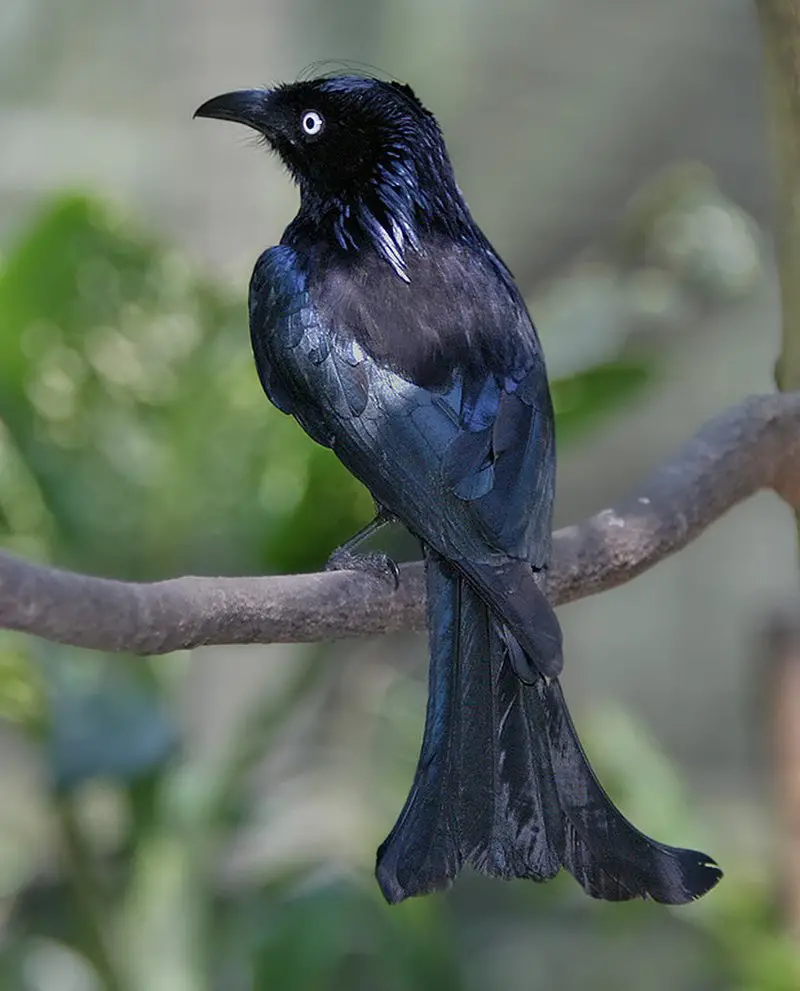
Drongos are an Old World tropical family of passerine birds belonging to the Dicruridae genus.
They have short legs, forked tails and a distinctive upright stance when perched.
Depending on the species they may be mostly black or dark grey in colour with some having elaborate tail decorations.
Drongos feed mainly on insects and small birds – catching them both in flight and from the ground.
They also sometimes eat fruit, nectar and even carcasses.
The drongo’s unique adaptations make it one of nature’s most successful hunters; able to survive almost anywhere in their natural range across Africa, Asia & Australia.
Scientific classification:
| Kingdom | Animalia |
| Phylum | Chordata |
| Class | Aves |
| Order | Passeriformes |
| Superfamily | Corvoidea |
| Family | Dicruridae Vigors, 1825 |
| Genus | Dicrurus Vieillot, 1816 |
Also Featured In: Birds of United Arab Emirates, Common Uzbekistan Birds
32. Brown-Headed Gull
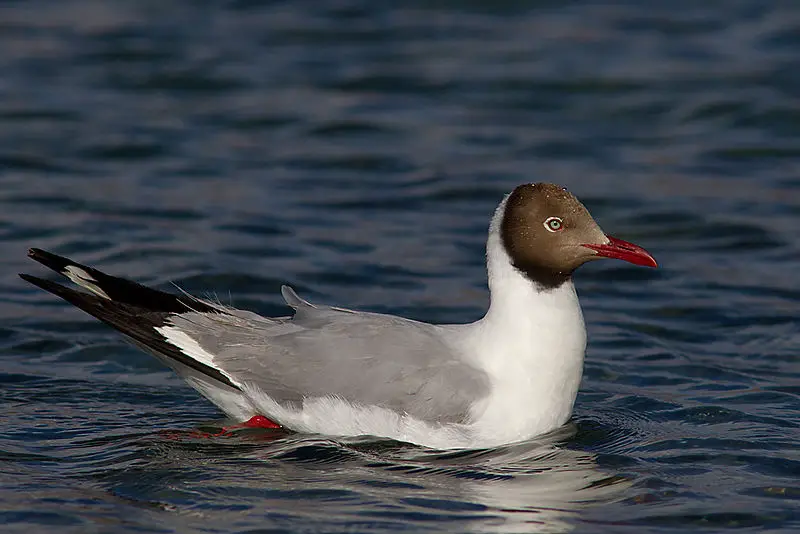
The Brown-headed Gull is a small species of gull that breeds in the high plateaus of Central Asia, from Tajikistan to Inner Mongolia.
During winter it migrates southward and can be seen along coastal areas and large inland lakes throughout the Indian Subcontinent.
They usually breed in colonies within reedbeds or marshes, constructing nests out of sticks on top of trees or among tall vegetation.
These birds have brown heads while their bodies are white with black wing tips; they also feature bright yellow eyes which give them an intense yet endearing look.
Their diet consists mainly fish but they’ll also consume insects, molluscs, crustaceans as well as other invertebrates and even plant matter during seasons when food is scarce.
Despite their shy nature towards humans these amazing birds make for wonderful wildlife watching opportunities.
Scientific classification:
| Kingdom | Animalia |
| Phylum | Chordata |
| Class | Aves |
| Order | Charadriiformes |
| Family | Laridae |
| Genus | Chroicocephalus |
| Species | C. brunnicephalus |
Also Featured In: Most Common Birds in Tajikistan, Birds of Ladakh
33. Barred Buttonquail
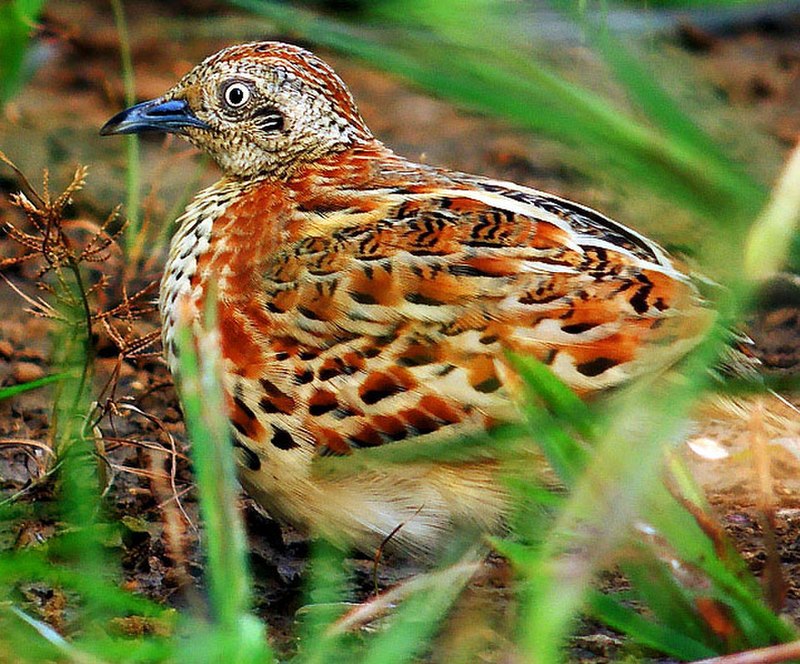
The Barred Buttonquail, also known as the Common Bustard-Quail is a small species of bird that originates in India and extends across tropical Asia to South China, Indonesia and the Philippines.
It was formally described by German naturalist Johann Friedrich Gmelin in 1789.
This buttonquail looks similar to true quails but it belongs to its own family; they have brown plumage with black barring on their wings and tail feathers.
They mainly feed on insects like beetles, grasshoppers and other invertebrates found amongst leaf litter or tall vegetation cover.
Their diet also includes grains such as wheat or corn for added nutrition during breeding season when females are laying eggs for incubation purposes until hatching occurs after about 18 days.
Scientific classification:
| Kingdom | Animalia |
| Phylum | Chordata |
| Class | Aves |
| Order | Charadriiformes |
| Family | Turnicidae |
| Genus | Turnix |
| Species | T. suscitator |
Also Featured In: Singapore Birds, Big Birds that Live in Singapore
34. Common Iora
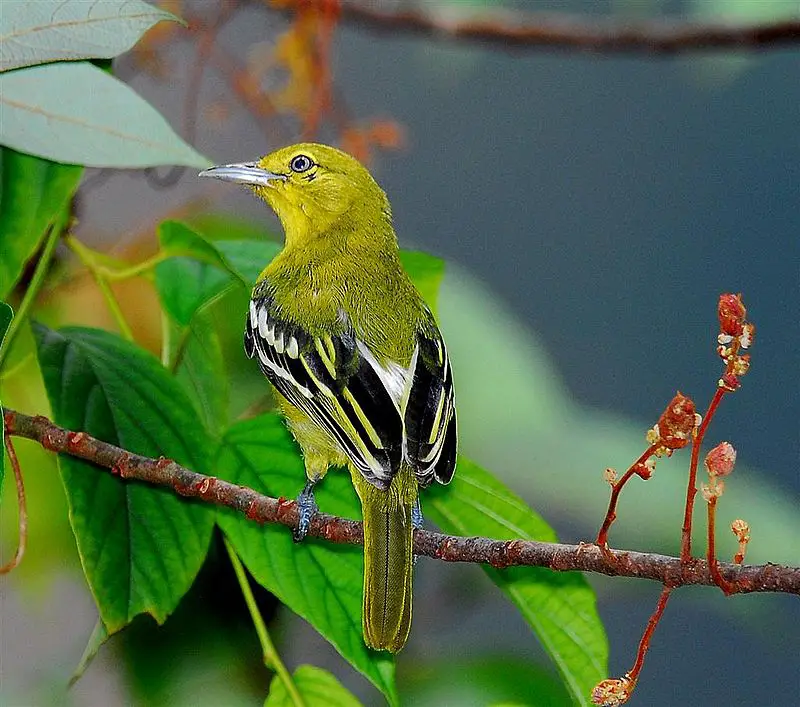
The Common Iora is a bright, small songbird that can be found in the tropical regions of India and Southeast Asia. It has distinctive loud whistles which help to identify it among other passerines.
Its plumage varies depending on where it lives, with some populations having different subspecies-specific colours.
During breeding season males display their feathers by fluffing them up and singing loudly to attract potential mates; females are mostly drabber coloured than the males but still have striking features such as yellow or green wings and tail feathers.
The common iora feeds mainly on insects, using its long bill bent at an angle near its tip to probe for food inside trees’ bark crevices or even into flowers while hovering mid-air.
This bird is usually seen in scrublands and forests but can also sometimes be spotted around urban areas too like parks or gardens
Scientific classification:
| Kingdom | Animalia |
| Phylum | Chordata |
| Class | Aves |
| Order | Passeriformes |
| Family | Aegithinidae |
| Genus | Aegithina |
| Species | A. tiphia |
35. Greater Sand Plover
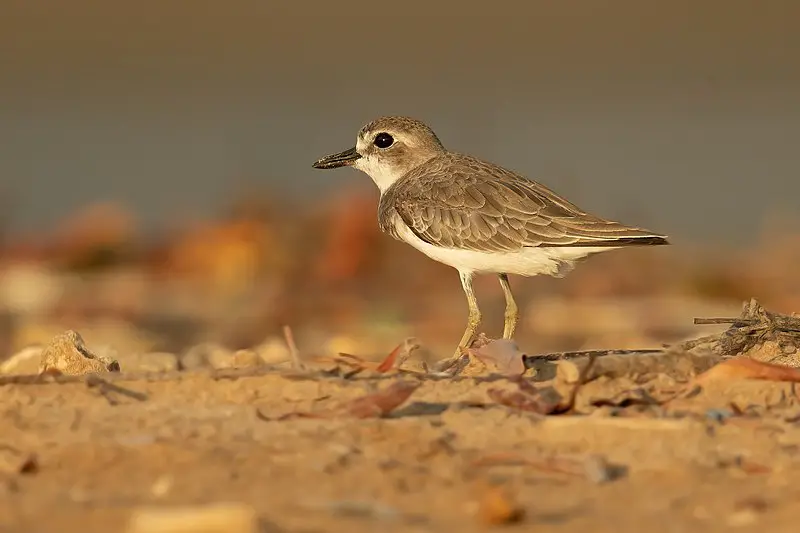
The Greater Sand Plover is a small wader, belonging to the plover family of birds. It’s scientific name Charadrius leschenaultii comes from the Latin word for a yellowish bird mentioned in the 4th century Vulgate.
These birds are typically found along coasts and sandy beaches where they feed on insects, mollusks and crustaceans.
They have grey-brown upperparts with white underparts and characteristic black bands across their chest as well as a prominent white forehead patch.
The Greater Sand Plovers breed mainly in India, Southeast Asia, Northern Australia and New Guinea while migrating to wintering grounds at coasts around South East Asia during nonbreeding season.
This species relies heavily on coastal wetlands so it is essential that these habitats be preserved in order for this species to survive into future generations.
Scientific classification:
| Kingdom | Animalia |
| Phylum | Chordata |
| Class | Aves |
| Order | Charadriiformes |
| Family | Charadriidae |
| Genus | Charadrius |
| Species | C. leschenaultii |
Also Featured In: Qatar birds, Common Townsville Birds
36. Indian Cormorant
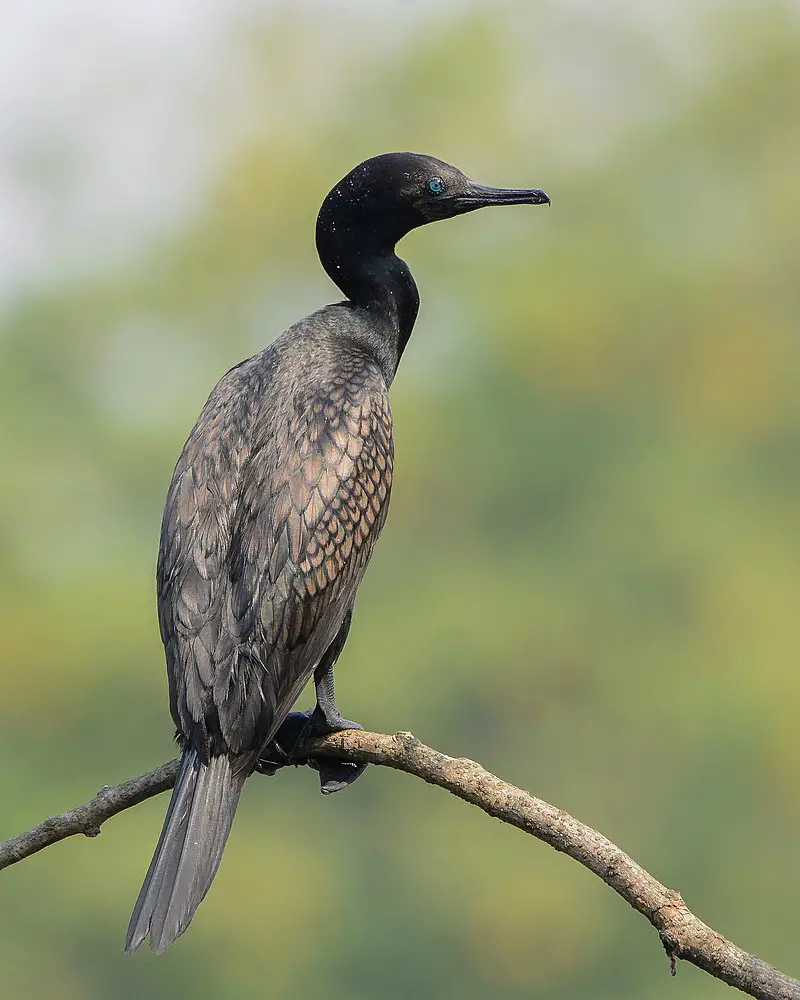
The Indian Cormorant is a beautiful bird found in the inland waters of India, stretching from Sind to Thailand and Cambodia.
It belongs to the cormorant family and has an unmistakable blue eye which sets it apart from other birds like its size-similar little cormorant.
The head is small with sloping forehead while there’s a long narrow neck connecting it to its body.
These birds are gregarious by nature, usually seen together in groups near water bodies or on land banks closeby.
They have powerful webbed feet for swimming as well as diving under water for their food – mainly fish along with some aquatic invertebrates and frogs too.
All these features make this species truly unique so keep your eyes peeled if you’re lucky enough spot them.
Scientific classification:
| Kingdom | Animalia |
| Phylum | Chordata |
| Class | Aves |
| Order | Suliformes |
| Family | Phalacrocoracidae |
| Genus | Phalacrocorax |
| Species | P. fuscicollis |
Also Featured In: Maldives birds,
37. Greater Crested Tern
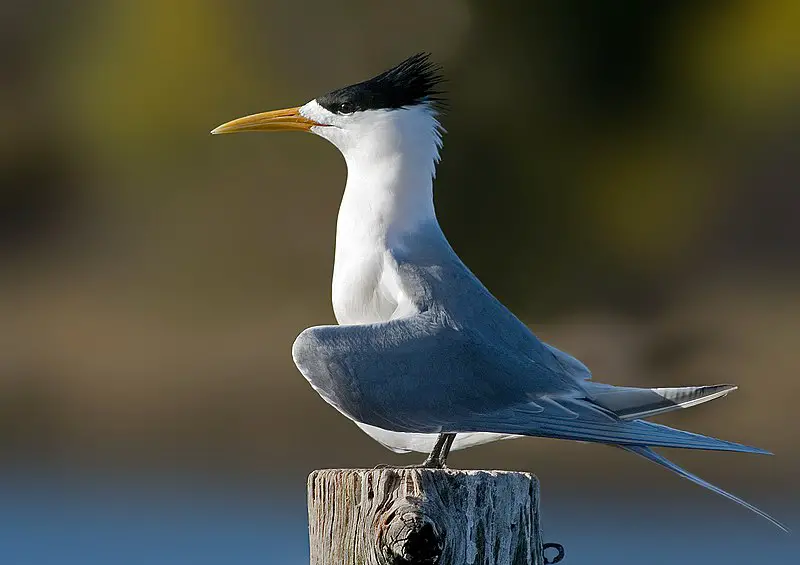
The Greater crested tern is a large bird of the family Laridae, found in tropical and subtropical regions across the Old World.
It has five subspecies which breed from South Africa to Australia, before migrating away for winter.
The distinctive crest feathers on its head give it its name and set it apart from other species like gulls or skuas.
They have wide wingspans that allow them to fly swiftly over oceans or coasts with ease – they are known as swift terns because of this.
The greater crested tern feeds mainly off fish caught at sea by plunge-diving into waters up to 10m deep; an impressive feat indeed.
With their bright white plumage, black caps and long yellow bills they stand out against any landscape – even on land these birds can be seen enjoying life along coastlines.
Scientific classification:
| Kingdom | Animalia |
| Phylum | Chordata |
| Class | Aves |
| Order | Charadriiformes |
| Family | Laridae |
| Genus | Thalasseus |
| Species | T. bergii |
Also Featured In: New South Wales Birds You Need to See, Birds that Live in Gold Coasts
38. Shikra
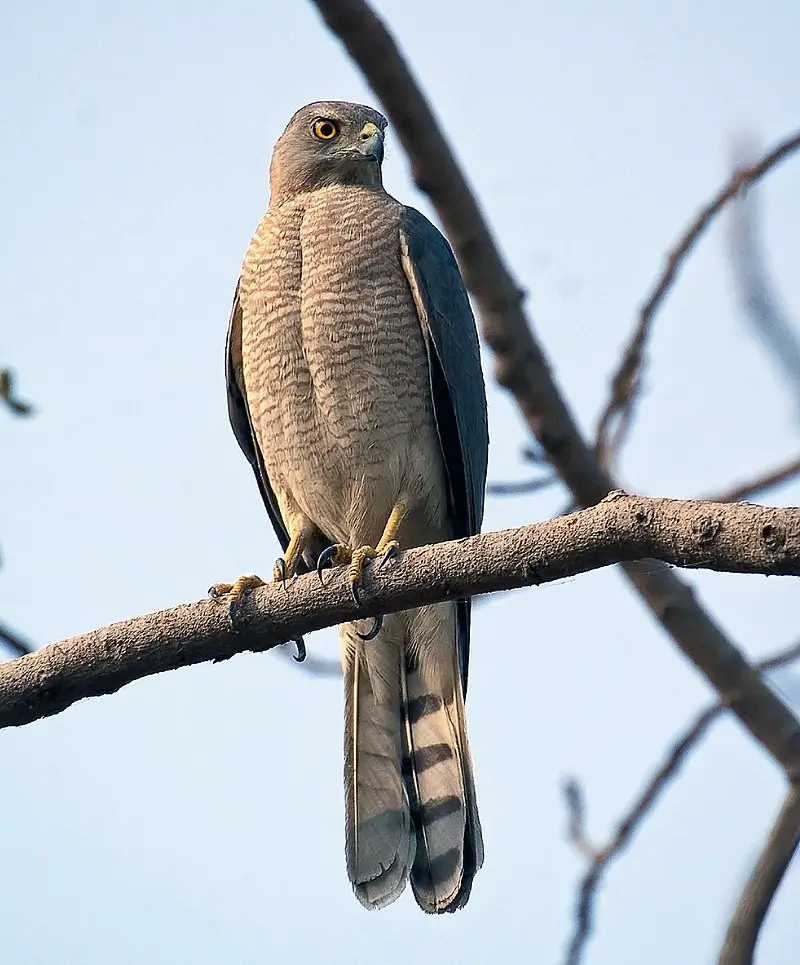
The Shikra bird, also known as the little banded goshawk, is a widespread bird of prey found in Asia and Africa. It is a small species belonging to the Accipitridae family.
The African variations of the Shikra may potentially represent a distinct species, but they are usually considered subspecies.
This bird has physical similarities to other sparrowhawk species, such as the Chinese Goshawk and Eurasian Sparrowhawk.
The Shikra is a quick predator and possesses excellent hunting skills. It typically preys on small mammals, reptiles, and birds.
The bird is known for its distinctive hunting technique, which involves a sudden dash and a quick silent strike to capture its victim.
Its plumage consists of brown or greyish-brown feathers with white and fine black streaks.
Overall, the Shikra bird is an impressive bird of prey, known for its versatility and hunting prowess.
Scientific classification:
| Kingdom | Animalia |
| Phylum | Chordata |
| Class | Aves |
| Order | Accipitriformes |
| Family | Accipitridae |
| Genus | Accipiter |
| Species | A. badius |
Also Featured In: Birds That Live in the Jungle, Native Birds of Kazakhstan
39. Brown-Headed Barbet
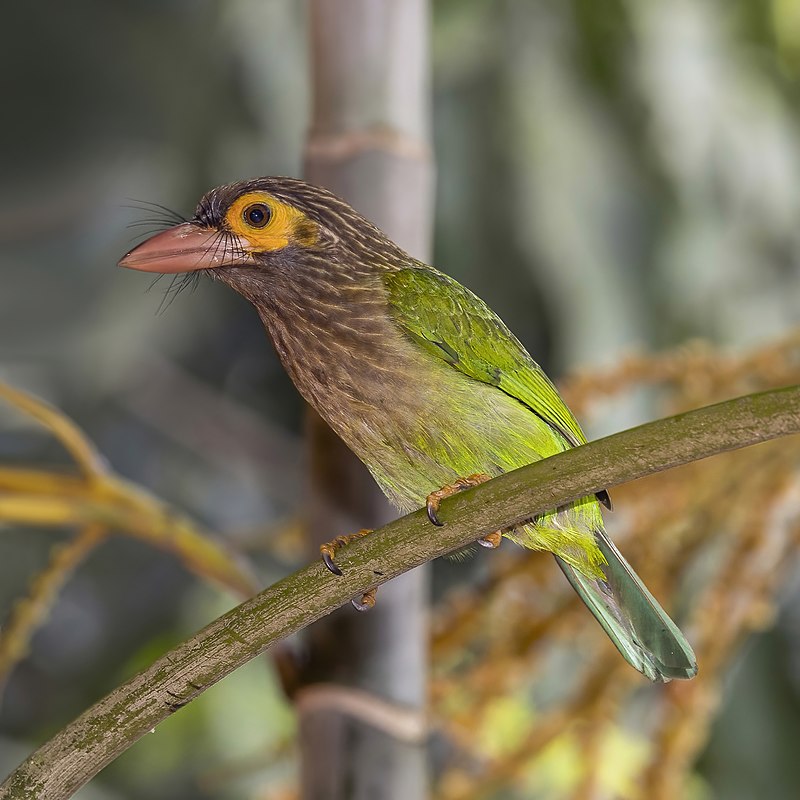
The Brown-headed barbet is an Asian bird that lives in the moist broadleaf forests of the Indian subcontinent. Johann Friedrich Gmelin described it in 1788 as part of the puffbird family.
The Brown-headed barbet has a distinct brown head and a green body. They are known for their distinctive calls, which can be heard echoing through the forests.
These birds feed on insects and fruits, using their strong beaks to break open nuts and seeds.
They are cavity nesters, making their homes in holes in trees. The Brown-headed barbet is considered a species of least concern, although its habitats are threatened by deforestation and human activities.
Their colorful appearance and unique calls make them a delight for birdwatchers to spot in the wild.
Scientific classification:
| Kingdom | Animalia |
| Phylum | Chordata |
| Class | Aves |
| Order | Piciformes |
| Family | Megalaimidae |
| Genus | Psilopogon |
| Species | P. zeylanicus |
Also Featured In: Common Birds that Live in Odisha, Delhi Birds You Need to See
40. Woolly-Necked Stork
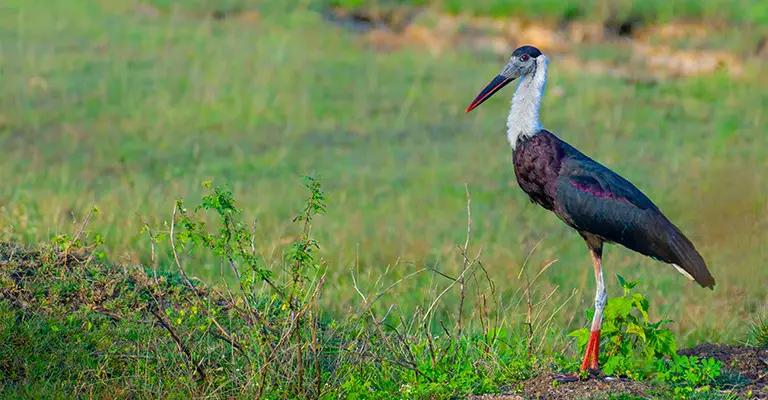
The woolly-necked stork, also known as the Asian woollyneck, belongs to the stork family and is a large wading bird.
It can be found in various habitats including forests, wetlands, and agricultural areas throughout Asia.
This bird typically breeds alone or in small groups. It is known for its long and beautiful feathers that appear woolly in texture around its neck.
The woolly-necked stork was first described by Georges-Louis Leclerc, a French polymath.
It is an important species for its role in maintaining the ecological balance within its habitat.
While their numbers may vary across different regions, these unique birds have come to be appreciated and admired by many.
Scientific classification:
| Kingdom | Animalia |
| Phylum | Chordata |
| Class | Aves |
| Order | Ciconiiformes |
| Family | Ciconiidae |
| Genus | Ciconia |
| Species | C. episcopus |
Also Featured In: Birds that Commonly Found in Bali, Birds of Karnataka
41. Plum-Headed Parakeet
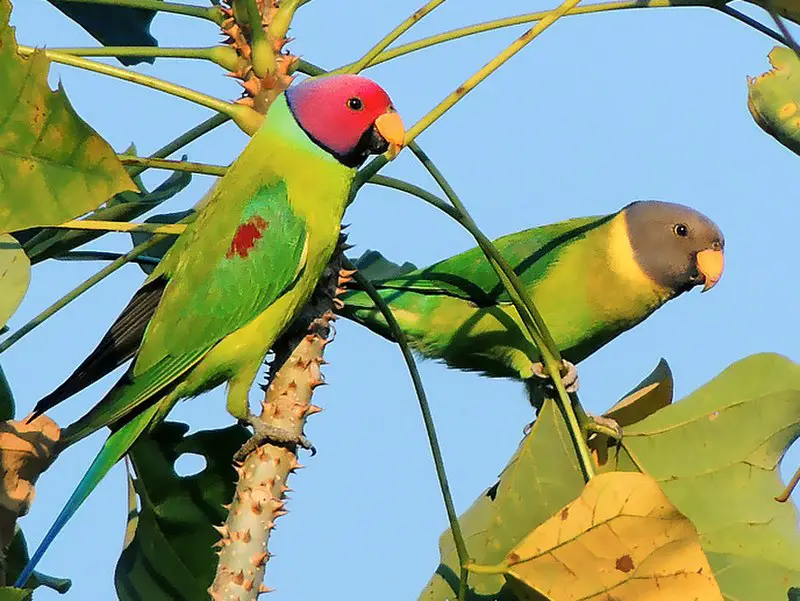
The Plum-headed parakeet is a bird in the Psittacidae family, endemic to the Indian Subcontinent. It was once considered the same species as the blossom-headed parakeet, but has been recognized as a distinct species.
Males have a pinkish-purple head, while females have a grey head. They fly swiftly in flocks, and are known for their vibrant colors.
Their diet typically consists of fruits, flowers and seeds. These birds are popular among bird enthusiasts for their beauty and entertaining personalities.
They are also considered a pest by some farmers, as they can cause damage to crops.
Despite this, the Plum-headed parakeet remains a much-loved bird in the Indian subcontinent, and is considered a symbol of love and romance in some cultures.
Scientific classification:
| Kingdom | Animalia |
| Phylum | Chordata |
| Class | Aves |
| Order | Psittaciformes |
| Family | Psittaculidae |
| Genus | Psittacula |
| Species | P. cyanocephala |
Also Featured In: Pet Birds that Live in India,
42. Sandpiper
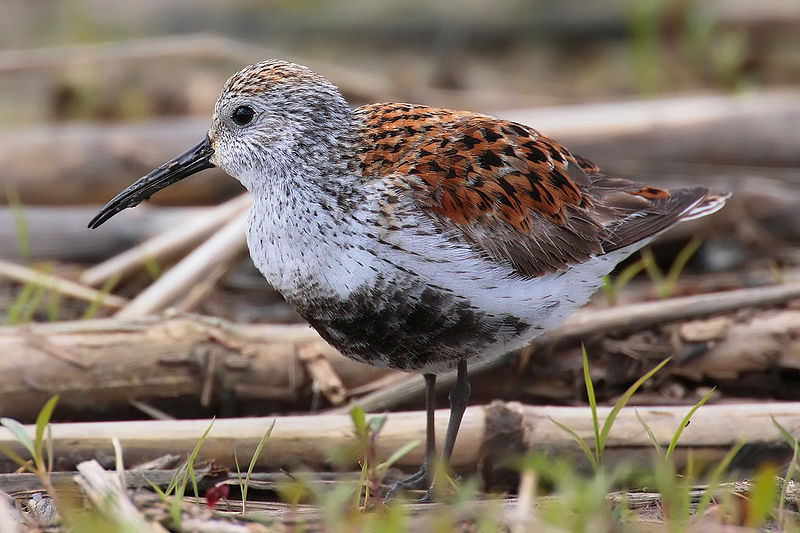
Sandpiper is a type of wading bird that belongs to the family Scolopacidae. It is a diverse family that includes various species such as curlew and snipe.
Sandpipers have different bill lengths that allow them to feed on small invertebrates and creatures found in mud or soil.
Due to this diversity, different species can coexist in the same habitat without competing for food.
Sandpipers are commonly found near the coast but are also found in other wetland environments.
They are known for their slender legs, long beak, and streamlined body that enables them to move easily in and out of water.
Sandpipers are a unique and fascinating bird species that are interesting to observe in their natural habitat.
Scientific classification:
| Kingdom | Animalia |
| Phylum | Chordata |
| Class | Aves |
| Order | Charadriiformes |
| Suborder | Scolopaci |
| Family | Scolopacidae Rafinesque, 1815 |
Also Featured In: Birds You’ll Find in the Sea, Turkey Birds You Should Know
43. Greater Spotted Eagle
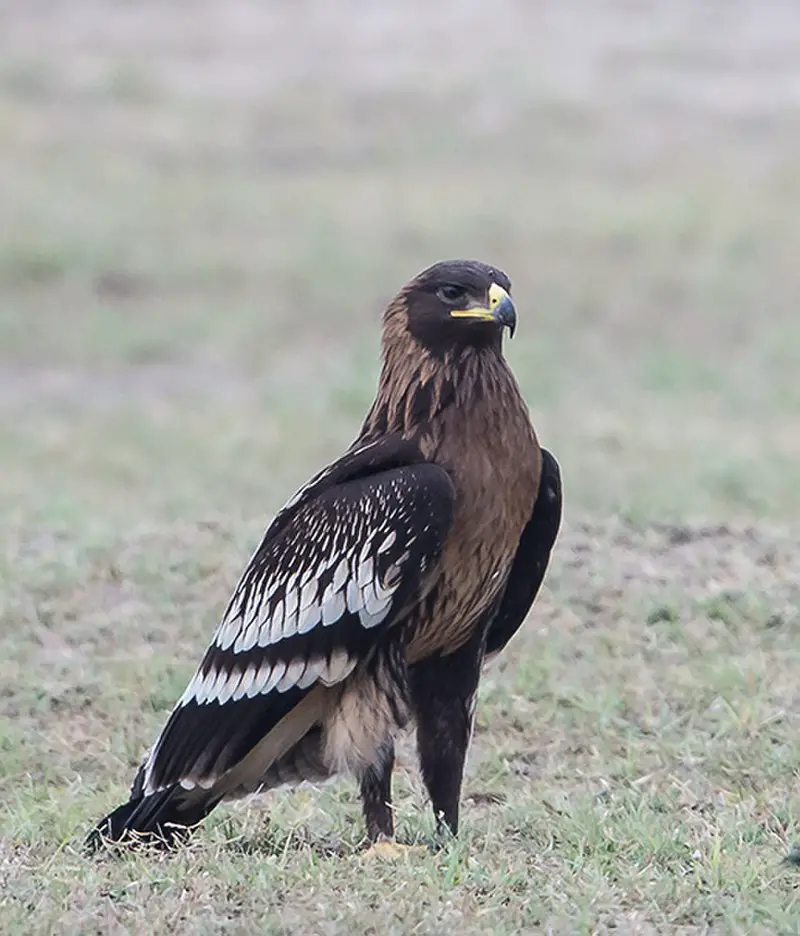
The greater spotted eagle is a large bird of prey that belongs to the Accipitridae family. It is also known as the spotted eagle and has feathered legs that indicate its membership in the subfamily Aquilinae, also called the “booted eagles.”
Although previously considered a member of the Aquila genus, it has been recently reclassified in the Clanga genus, along with other eagle species.
The greater spotted eagle is a magnificent bird with a wingspan of up to 2 meters and is known for its hunting skills.
Due to habitat loss and degradation, its population has been declining, leading it to be classified as a vulnerable species on the IUCN Red List.
Conservation efforts are needed to ensure the survival and protection of this majestic bird.
Scientific classification:
| Kingdom | Animalia |
| Phylum | Chordata |
| Class | Aves |
| Order | Accipitriformes |
| Family | Accipitridae |
| Genus | Clanga |
| Species | C. clanga |
Also Featured In: Syrian Birds You Need to Know, Belarus Birds You Should Know
44. Crested Goshawk
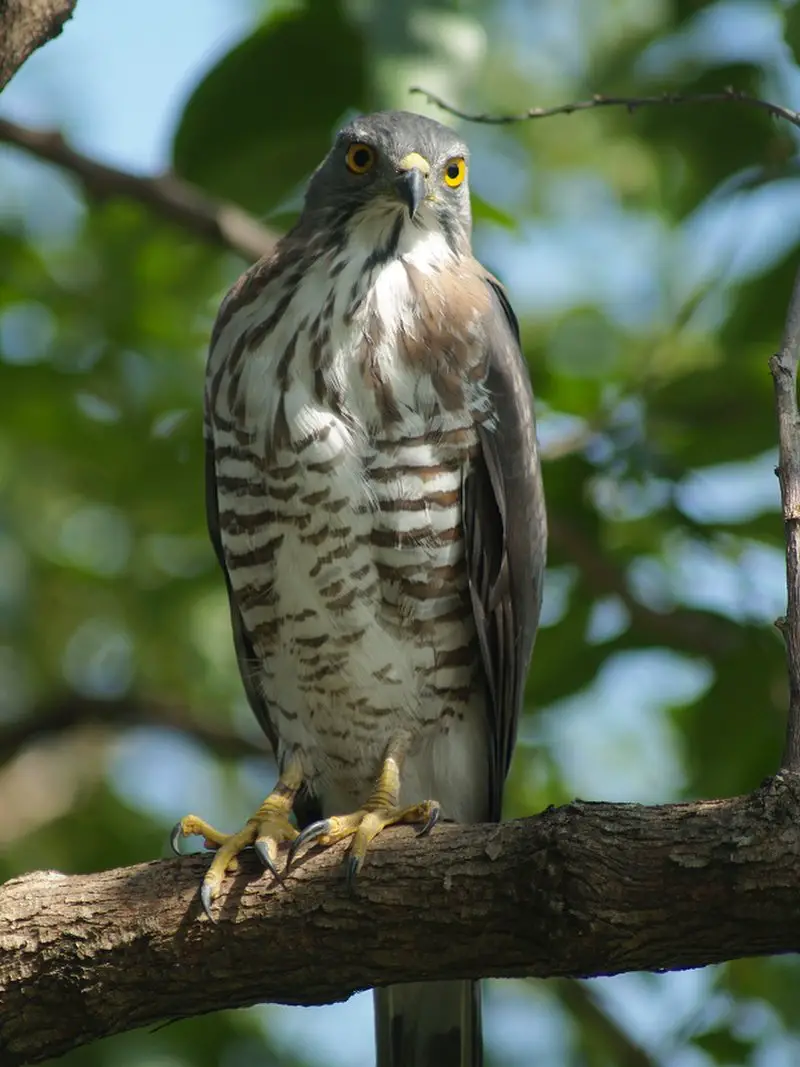
The Crested Goshawk bird is a diurnal raptor found in tropical Asia. Belonging to the Accipitridae family, it shares characteristics with buzzards, harriers, and eagles.
Its wings are short and broad, with a long tail, aiding in its movement through trees. The larger female Crested Goshawk can grow up to 46 cm in length, much bigger than the male.
These birds are skilled hunters and have adapted well to their forest habitats, using their sharp talons and beaks to catch prey.
Despite their ferocity, Crested Goshawks are still threatened by habitat destruction across Asia, rendering them vulnerable in many regions.
Overall, the Crested Goshawk bird is a graceful predator that perfectly exemplifies the beauty and ferocity of the natural world.
Scientific classification:
| Kingdom | Animalia |
| Phylum | Chordata |
| Class | Aves |
| Order | Accipitriformes |
| Family | Accipitridae |
| Genus | Accipiter |
| Species | A. trivirgatus |
Also Featured In: Most Common Taiwan Birds, Ko Mak Birds You Didn’t Know
45. Brown-Cheeked Fulvetta
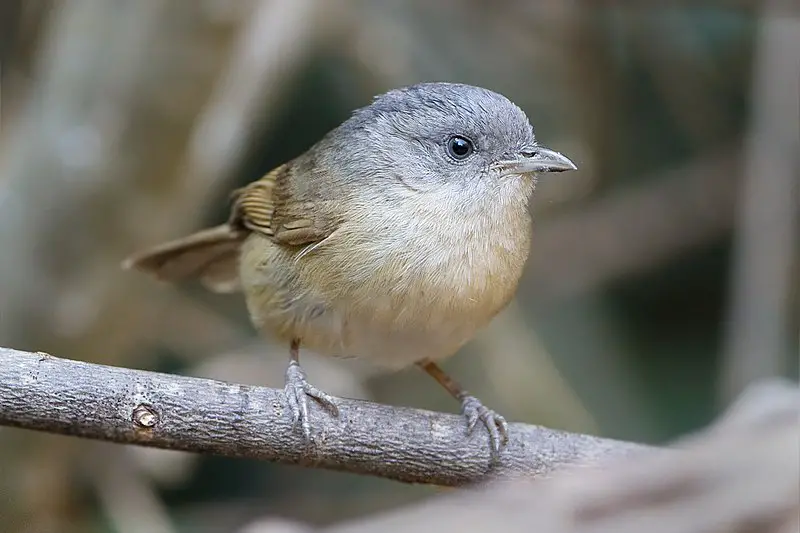
The Brown-cheeked fulvetta belongs to the family Alcippeidae and was previously known as the quaker babbler. Unlike true fulvettas, this species is considered as part of the genus Alcippe.
The bird has a characteristic brown cheek and is native to certain regions of Asia. The Brown-cheeked fulvetta is not related to the fulvettas proper, which were removed from the group due to their lack of connectivity.
This bird is known for its distinct vocalization, often heard from within dense vegetation. These birds are primarily insectivorous and have a broad distribution range in their native habitat.
They are also known to form mixed-species flocks with other birds, such as warblers and flycatchers.
Overall, the Brown-cheeked fulvetta is a unique and interesting bird species worth appreciating.
Scientific classification:
| Kingdom | Animalia |
| Phylum | Chordata |
| Class | Aves |
| Order | Passeriformes |
| Family | Alcippeidae |
| Genus | Alcippe |
| Species | A. poioicephala |
46. White-Cheeked Barbet
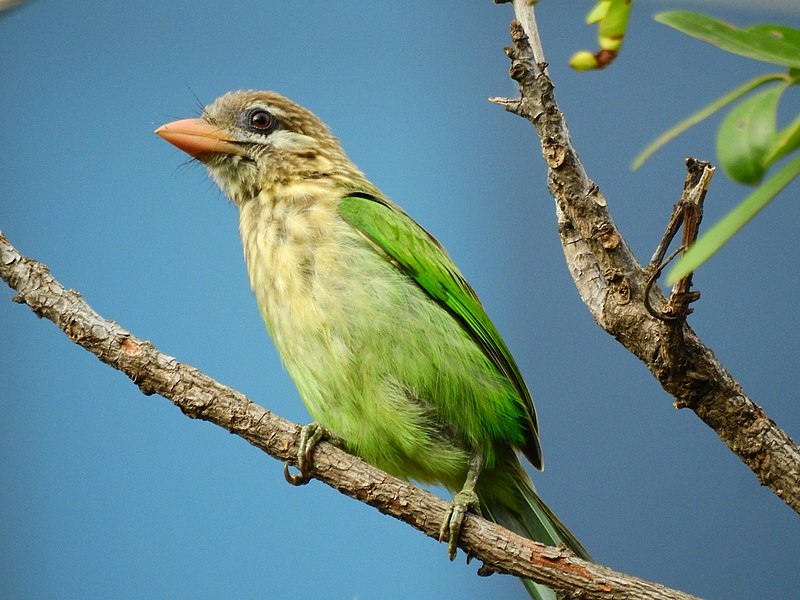
The White-cheeked barbet, also known as the Small Green barbet or Psilopogon viridis, is a bird species found in southern India.
This bird closely resembles the Brown-headed barbet but has a prominent supercilium and a broad white cheek stripe below the eye.
It inhabits the forested areas of the Western Ghats and parts of the Eastern Ghats. The White-cheeked barbet is known for its beautiful and melodic calls that echo through the dense forest.
It is a frugivorous bird that feeds on various fruits and berries. The breeding season of this bird is from February to August, during which it digs a hole in a tree trunk and lays up to four eggs.
The growing population of the White-cheeked barbet is an indicator of the healthy forest ecosystem in India.
Scientific classification:
| Kingdom | Animalia |
| Phylum | Chordata |
| Class | Aves |
| Order | Piciformes |
| Family | Megalaimidae |
| Genus | Psilopogon |
| Species | P. viridis |
Also Featured In: Common Birds in Kerala, Common Birds in Bangalore
47. Greater Racket-Tailed Drongo
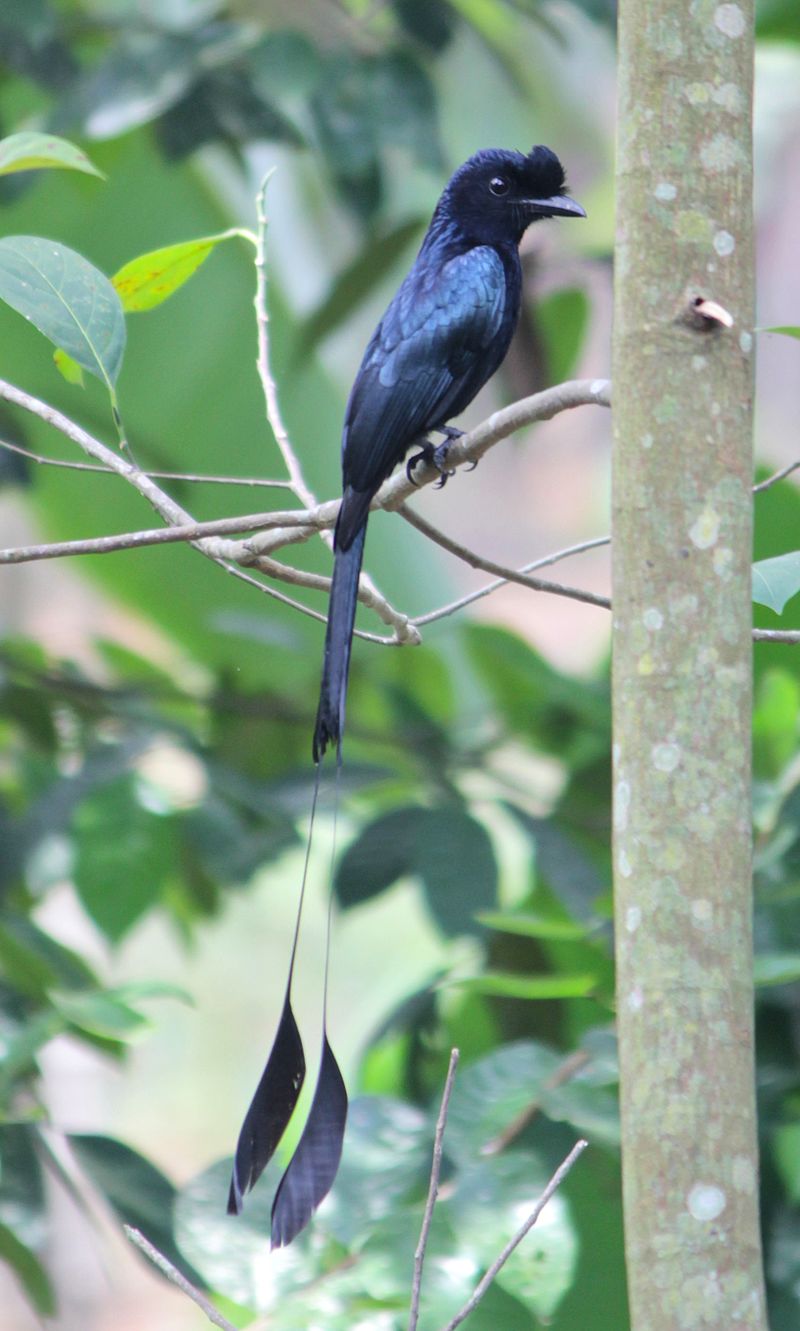
The Greater racket-tailed drongo is a medium-sized bird that inhabits forests in Asia. This bird is easily recognized by its elongated outer tail feathers which have webbing only at the tips.
The Greater racket-tailed drongo is part of the Dicruridae family, which also includes other types of drongos.
They are known for their conspicuous nature, often perching out in the open and using a variety of loud calls that include perfect mimicry of other birds and animals.
They are skilled at attracting attention, and can be seen flashing their long tails to intimidate predators or attract mates.
The Greater racket-tailed drongo is an important member of its ecosystem, helping to control insect populations and acting as a key prey species for predators.
Overall, this bird is a fascinating and important species of the Asian forests it inhabits.
Scientific classification:
| Kingdom | Animalia |
| Phylum | Chordata |
| Class | Aves |
| Order | Passeriformes |
| Family | Dicruridae |
| Genus | Dicrurus |
| Species | D. paradiseus |
Also Featured In: Endemic Sri Lanka Birds, Common Birds of Hainan
48. Jungle Owlet
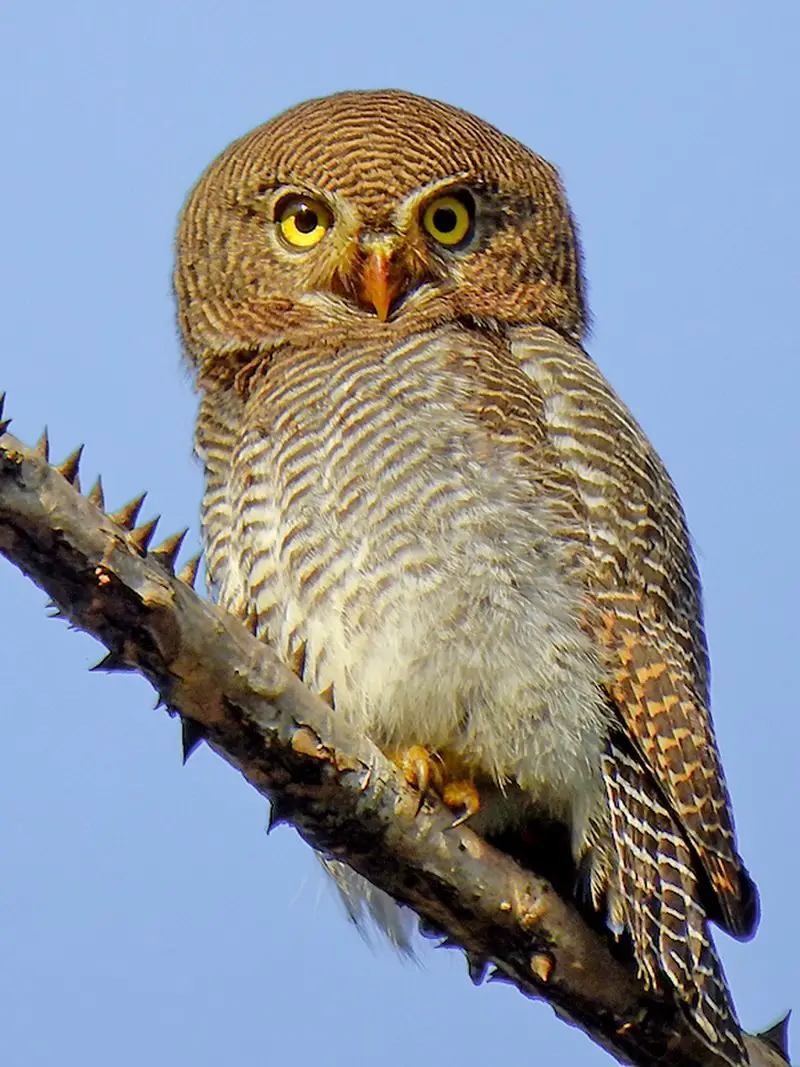
The jungle owlet is a small bird that is native to the Indian Subcontinent. It is also known as the barred jungle owlet and is often found alone or in small groups.
Their calls are heard at dawn and dusk. There are two subspecies of the jungle owlet, with the one found in the Western Ghats potentially being a separate species. They have a rounded head and are finely barred all over.
Scientific classification:
| Kingdom | Animalia |
| Phylum | Chordata |
| Class | Aves |
| Order | Strigiformes |
| Family | Strigidae |
| Genus | Glaucidium |
| Species | G. radiatum |
Also Featured In: Gujarati Birds, Birds You’ll Find in Kanha National Park
49. Chestnut-Headed Bee-Eater
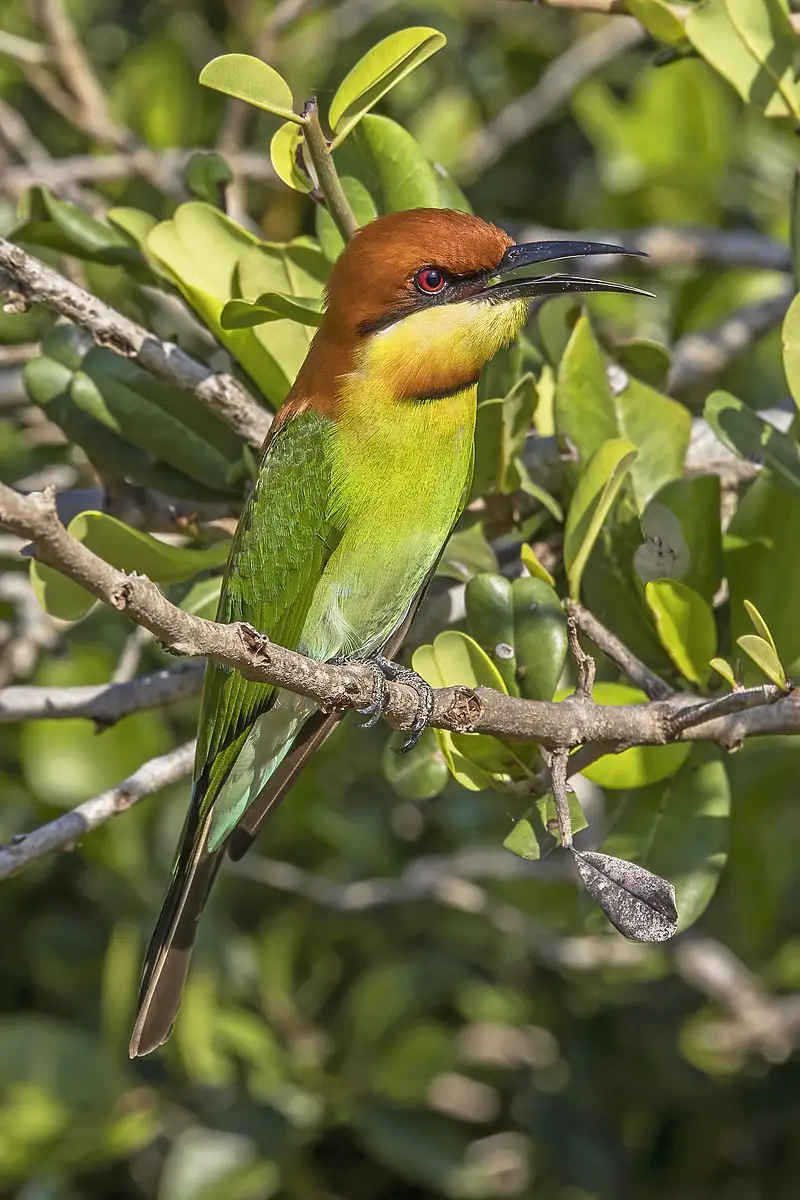
The Chestnut-headed bee-eater is a vibrantly colourful bird found in the Indian subcontinent and neighbouring regions. It belongs to the bee-eater family and is a resident breeder.
The bird is slender and has a predominantly green body, along with blue on the rump and lower belly. The bird’s chestnut head is its most distinguishing feature, which gives it its name.
The bird’s beak is long, pointed and slightly curved, ideal for catching insects, its primary food. These birds prefer living in open and wooded habitats like gardens and deciduous forests.
They are known for their swift flight and have the ability to catch insects while airborne. These birds have a unique nesting behaviour, where they use their beaks to excavate holes in vertical sandbanks or similar substrates.
Despite their beauty and unique characteristics, these birds are vulnerable to habitat loss and deforestation, making conservation efforts more critical than ever.
Scientific classification:
| Kingdom | Animalia |
| Phylum | Chordata |
| Class | Aves |
| Order | Coraciiformes |
| Family | Meropidae |
| Genus | Merops |
| Species | M. leschenaulti |
Also Featured In: Common Birds of Chhattisgarh,
50. Crested Treeswift
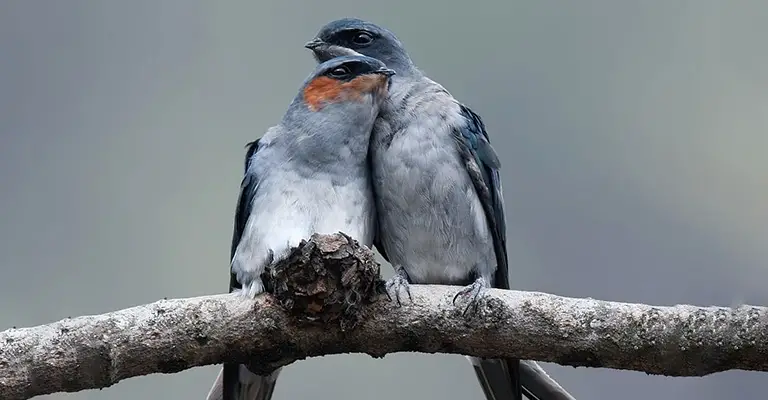
The crested treeswift bird is a species of tree swift and is distinct in flight with its long, bowed wings and deeply forked tail.
It is often confused with its eastern relative, the gray-rumped treeswift, but they do not interbreed where their ranges overlap.
This bird has a pointed appearance and can be recognized by its crested head. The crested treeswift is a large bird that is known for its ability to fly long distances with ease.
It is often found in forested areas and feeds on insects which it catches while in flight.
This bird is a beautiful addition to any natural environment and is a joy to observe in flight.
Scientific classification:
| Kingdom | Animalia |
| Phylum | Chordata |
| Class | Aves |
| Clade | Strisores |
| Order | Apodiformes |
| Family | Hemiprocnidae |
| Genus | Hemiprocne |
| Species | H. coronata |
51. Brown Boobook
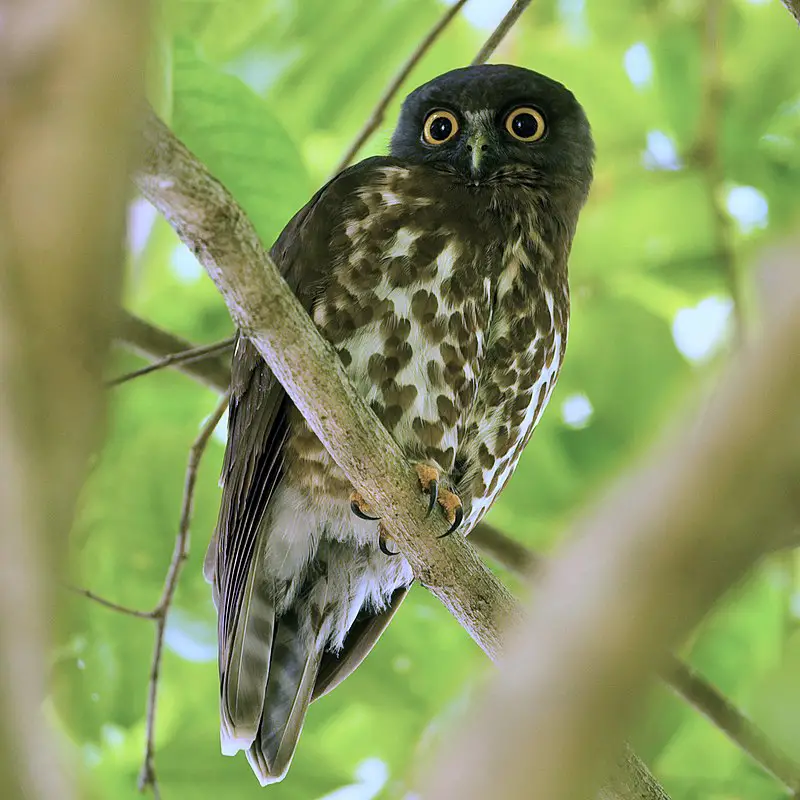
The Brown boobook, also called Brown hawk-owl, is a resident bird breed in South Asia that can be found from India to Western Indonesia and south China.
This owl belongs to the Strigidae family, and it’s part of the typical owls group, which comprises most species of this bird. The Brown boobook has a brown plumage, a round head, and big black eyes.
This owl is known for being an excellent predator; it hunts mainly at night by using its sharp talons and swift flight.
Besides, the Brown boobook can produce a variety of calls, from low hoots to high-pitched screeches.
Despite being a common bird, the Brown boobook faces threats, including deforestation and habitat loss, which could endanger its survival in some regions.
Scientific classification:
| Kingdom | Animalia |
| Phylum | Chordata |
| Class | Aves |
| Order | Strigiformes |
| Family | Strigidae |
| Genus | Ninox |
| Species | N. scutulata |